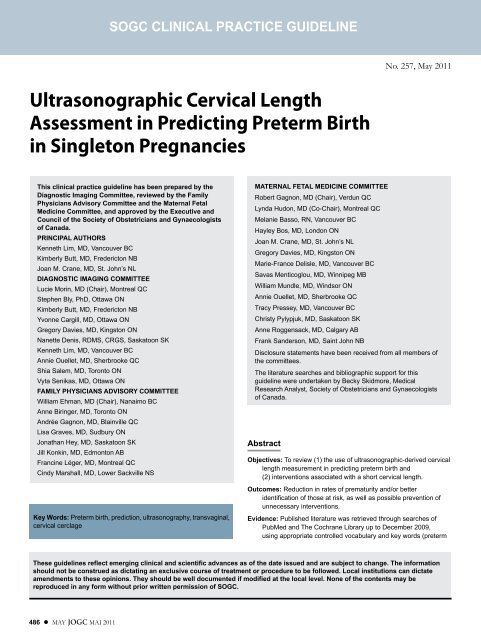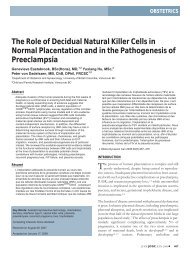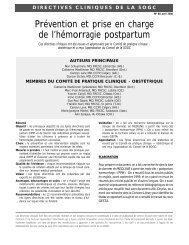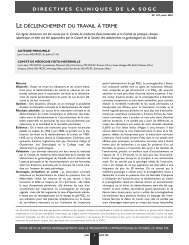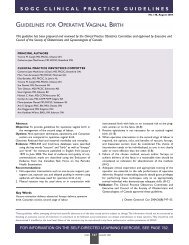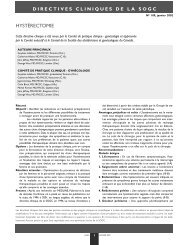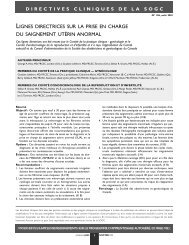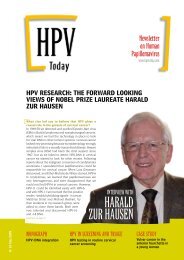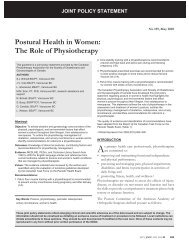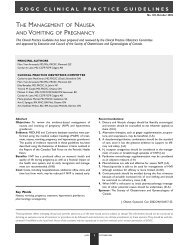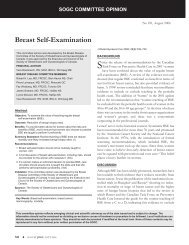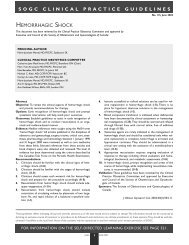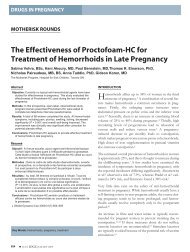Ultrasonographic Cervical Length Assessment in Predicting ... - SOGC
Ultrasonographic Cervical Length Assessment in Predicting ... - SOGC
Ultrasonographic Cervical Length Assessment in Predicting ... - SOGC
Create successful ePaper yourself
Turn your PDF publications into a flip-book with our unique Google optimized e-Paper software.
486 l MAY JOGC MAI 2011<br />
<strong>SOGC</strong> CLINICAL PRACTICE GUIDELINE<br />
<strong>Ultrasonographic</strong> <strong>Cervical</strong> <strong>Length</strong><br />
<strong>Assessment</strong> <strong>in</strong> Predict<strong>in</strong>g Preterm Birth<br />
<strong>in</strong> S<strong>in</strong>gleton Pregnancies<br />
This cl<strong>in</strong>ical practice guidel<strong>in</strong>e has been prepared by the<br />
Diagnostic Imag<strong>in</strong>g Committee, reviewed by the Family<br />
Physicians Advisory Committee and the Maternal Fetal<br />
Medic<strong>in</strong>e Committee, and approved by the Executive and<br />
Council of the Society of Obstetricians and Gynaecologists<br />
of Canada.<br />
PRINCIPAL AUTHORS<br />
Kenneth Lim, MD, Vancouver BC<br />
Kimberly Butt, MD, Fredericton NB<br />
Joan M . Crane, MD, St . John’s NL<br />
DIAGNOSTIC IMAGING COMMITTEE<br />
Lucie Mor<strong>in</strong>, MD (Chair), Montreal QC<br />
Stephen Bly, PhD, Ottawa ON<br />
Kimberly Butt, MD, Fredericton NB<br />
Yvonne Cargill, MD, Ottawa ON<br />
Gregory Davies, MD, K<strong>in</strong>gston ON<br />
Nanette Denis, RDMS, CRGS, Saskatoon SK<br />
Kenneth Lim, MD, Vancouver BC<br />
Annie Ouellet, MD, Sherbrooke QC<br />
Shia Salem, MD, Toronto ON<br />
Vyta Senikas, MD, Ottawa ON<br />
FAMILY PHYSICIANS ADVISORY COMMITTEE<br />
William Ehman, MD (Chair), Nanaimo BC<br />
Anne Bir<strong>in</strong>ger, MD, Toronto ON<br />
Andrée Gagnon, MD, Bla<strong>in</strong>ville QC<br />
Lisa Graves, MD, Sudbury ON<br />
Jonathan Hey, MD, Saskatoon SK<br />
Jill Konk<strong>in</strong>, MD, Edmonton AB<br />
Franc<strong>in</strong>e Léger, MD, Montreal QC<br />
C<strong>in</strong>dy Marshall, MD, Lower Sackville NS<br />
Key Words: Preterm birth, prediction, ultrasonography, transvag<strong>in</strong>al,<br />
cervical cerclage<br />
Abstract<br />
No. 257, May 2011<br />
MATERNAL FETAL MEDICINE COMMITTEE<br />
Robert Gagnon, MD (Chair), Verdun QC<br />
Lynda Hudon, MD (Co-Chair), Montreal QC<br />
Melanie Basso, RN, Vancouver BC<br />
Hayley Bos, MD, London ON<br />
Joan M . Crane, MD, St . John’s NL<br />
Gregory Davies, MD, K<strong>in</strong>gston ON<br />
Marie-France Delisle, MD, Vancouver BC<br />
Savas Menticoglou, MD, W<strong>in</strong>nipeg MB<br />
William Mundle, MD, W<strong>in</strong>dsor ON<br />
Annie Ouellet, MD, Sherbrooke QC<br />
Tracy Pressey, MD, Vancouver BC<br />
Christy Pylypjuk, MD, Saskatoon SK<br />
Anne Roggensack, MD, Calgary AB<br />
Frank Sanderson, MD, Sa<strong>in</strong>t John NB<br />
Disclosure statements have been received from all members of<br />
the committees .<br />
The literature searches and bibliographic support for this<br />
guidel<strong>in</strong>e were undertaken by Becky Skidmore, Medical<br />
Research Analyst, Society of Obstetricians and Gynaecologists<br />
of Canada .<br />
Objectives: To review (1) the use of ultrasonographic-derived cervical<br />
length measurement <strong>in</strong> predict<strong>in</strong>g preterm birth and<br />
(2) <strong>in</strong>terventions associated with a short cervical length .<br />
Outcomes: Reduction <strong>in</strong> rates of prematurity and/or better<br />
identification of those at risk, as well as possible prevention of<br />
unnecessary <strong>in</strong>terventions .<br />
Evidence: Published literature was retrieved through searches of<br />
PubMed and The Cochrane Library up to December 2009,<br />
us<strong>in</strong>g appropriate controlled vocabulary and key words (preterm<br />
These guidel<strong>in</strong>es reflect emerg<strong>in</strong>g cl<strong>in</strong>ical and scientific advances as of the date issued and are subject to change. The <strong>in</strong>formation<br />
should not be construed as dictat<strong>in</strong>g an exclusive course of treatment or procedure to be followed. Local <strong>in</strong>stitutions can dictate<br />
amendments to these op<strong>in</strong>ions. They should be well documented if modified at the local level. None of the contents may be<br />
reproduced <strong>in</strong> any form without prior written permission of <strong>SOGC</strong>.
labour, ultrasound, cervix, <strong>in</strong>competent cervix, transvag<strong>in</strong>al,<br />
transper<strong>in</strong>eal, cervical length, fibronect<strong>in</strong>) . Results were<br />
restricted to general and systematic reviews, randomized<br />
controlled trials/controlled cl<strong>in</strong>ical trials, and observational<br />
studies . There were no date or language restrictions . Grey<br />
(unpublished) literature was identified through search<strong>in</strong>g<br />
the websites of health technology assessment and health<br />
technology assessment-related agencies, cl<strong>in</strong>ical practice<br />
guidel<strong>in</strong>e collections, cl<strong>in</strong>ical trial registries, and national and<br />
<strong>in</strong>ternational medical specialty societies .<br />
Values: The evidence and this guidel<strong>in</strong>e were reviewed by the<br />
Diagnostic Imag<strong>in</strong>g Committee and the Maternal Fetal Medic<strong>in</strong>e<br />
Committee of the Society of Obstetricians and Gynaecologists of<br />
Canada, and the recommendations were made accord<strong>in</strong>g to the<br />
guidel<strong>in</strong>es developed by The Canadian Task Force on Preventive<br />
Health Care (Table 1) .<br />
Benefits, harms, and costs: Preterm birth is a lead<strong>in</strong>g cause of<br />
per<strong>in</strong>atal morbidity and mortality . Use of the ultrasonographic<br />
technique reviewed <strong>in</strong> this guidel<strong>in</strong>e may help identify women<br />
at risk of preterm birth and, <strong>in</strong> some circumstances, lead to<br />
<strong>in</strong>terventions that may reduce the rate of preterm birth .<br />
Sponsors: The Society of Obstetricians and Gynaecologists of<br />
Canada<br />
Summary Statements<br />
1 . <strong>Cervical</strong> length <strong>in</strong> the general obstetrical population is relatively<br />
stable over the first 2 trimesters . The natural history of cervical<br />
length change may be useful <strong>in</strong> identify<strong>in</strong>g women at <strong>in</strong>creased<br />
risk of spontaneous preterm birth . Because there may be<br />
different patterns or a delay <strong>in</strong> cervical length shorten<strong>in</strong>g, repeat<br />
assessment of cervical length may be useful . (II-2)<br />
2 . There is no consensus on the optimal tim<strong>in</strong>g or frequency of<br />
serial evaluations of cervical length . If repeat measurements are<br />
performed, they should be done at suitable <strong>in</strong>tervals to m<strong>in</strong>imize<br />
the likelihood of observation error . (II-2)<br />
3 . Transvag<strong>in</strong>al sonography can be used to assess the risk of<br />
preterm birth <strong>in</strong> women with a history of spontaneous preterm<br />
birth and to differentiate those at higher and lower risk of preterm<br />
delivery . The gestational age of a prior preterm birth affects the<br />
cervical length <strong>in</strong> a future pregnancy . (II–2)<br />
4 . <strong>Cervical</strong> length measurement can be used to identify <strong>in</strong>creased<br />
risk of preterm birth <strong>in</strong> asymptomatic women at < 24 weeks who<br />
have other risk factors for preterm birth (previous excisional<br />
treatment for cervical dysplasia, uter<strong>in</strong>e anomaly, or prior<br />
multiple dilatation and evacuation procedures beyond 13 weeks’<br />
gestation) . However, there is <strong>in</strong>sufficient evidence to recommend<br />
specific management strategies, such as cerclage, <strong>in</strong> these<br />
women . (II-2)<br />
5 . No specific randomized trials have evaluated any <strong>in</strong>terventions<br />
<strong>in</strong> asymptomatic women at > 24 weeks’ gestation who are at<br />
<strong>in</strong>creased risk of preterm birth (e .g ., those who have a history of<br />
prior spontaneous preterm birth, previous excisional treatment<br />
for cervical dysplasia, uter<strong>in</strong>e anomaly, or prior multiple dilatation<br />
and evacuation procedures beyond 13 weeks’ gestation) and<br />
who have a short cervical length . This <strong>in</strong>formation may help with<br />
ABBREVIATIONS<br />
LEEP loop electrical excision procedure<br />
TP transper<strong>in</strong>eal<br />
TV transvag<strong>in</strong>al<br />
<strong>Ultrasonographic</strong> <strong>Cervical</strong> <strong>Length</strong> <strong>Assessment</strong> <strong>in</strong> Predict<strong>in</strong>g Preterm Birth <strong>in</strong> S<strong>in</strong>gleton Pregnancies<br />
empiric management of these women, <strong>in</strong>clud<strong>in</strong>g reduction of<br />
activity level, work, or travel, relocation, <strong>in</strong>creased surveillance,<br />
and adm<strong>in</strong>istration of corticosteroids . (III)<br />
6 . Transvag<strong>in</strong>al ultrasound appears to be safe <strong>in</strong> preterm premature<br />
rupture of membranes, but its cl<strong>in</strong>ical predictive value is uncerta<strong>in</strong><br />
<strong>in</strong> this context . (II-2)<br />
7 . It is unclear whether ultrasonographic cervical length assessment<br />
has significant advantages over cl<strong>in</strong>ical exam<strong>in</strong>ation alone after<br />
elective or emergency cervical cerclage placement, although<br />
some signs, such as funnell<strong>in</strong>g to the stitch, are associated with a<br />
high risk of preterm premature rupture of membranes . There is no<br />
consensus on the frequency or tim<strong>in</strong>g of ultrasonographic cervical<br />
length assessment post cerclage . (II-2)<br />
8 . It is unclear whether a policy of cervical length surveillance is<br />
equivalent to cl<strong>in</strong>ical assessment of the need for elective cerclage<br />
<strong>in</strong> those at risk of preterm delivery . (I)<br />
9 . <strong>Ultrasonographic</strong> cervical length assessment and fetal fibronect<strong>in</strong><br />
appear to be similar <strong>in</strong> predictive ability, and the comb<strong>in</strong>ation of<br />
both <strong>in</strong> a high-risk population may be of value . However, further<br />
research is needed <strong>in</strong> this area . (II-2)<br />
Recommendations<br />
1 . Transabdom<strong>in</strong>al ultrasonography should not be used for cervical<br />
length assessment to predict preterm birth . (II-2D)<br />
2 . Transvag<strong>in</strong>al ultrasonography is the preferred route for cervical<br />
assessment to identify women at <strong>in</strong>creased risk of spontaneous<br />
preterm birth and may be offered to women at <strong>in</strong>creased risk of<br />
preterm birth . (II-2B)<br />
3 . Transper<strong>in</strong>eal ultrasonography may be offered to women at<br />
<strong>in</strong>creased risk of preterm birth if transvag<strong>in</strong>al ultrasonography is<br />
either unacceptable or unavailable . (II-2B)<br />
4 . Because of poor positive predictive values and sensitivities and lack<br />
of proven effective <strong>in</strong>terventions, rout<strong>in</strong>e transvag<strong>in</strong>al cervical length<br />
assessment is not recommended <strong>in</strong> women at low risk . (II-2E)<br />
5 . In women present<strong>in</strong>g with suspected preterm labour, transvag<strong>in</strong>al<br />
sonographic assessment of cervical length may be used to help<br />
<strong>in</strong> determ<strong>in</strong><strong>in</strong>g who is at high risk of preterm delivery and may<br />
be helpful <strong>in</strong> prevent<strong>in</strong>g unnecessary <strong>in</strong>tervention . It is unclear<br />
whether this <strong>in</strong>formation results <strong>in</strong> a reduced risk of preterm birth .<br />
(II-2B)<br />
6 . In asymptomatic women with a history of spontaneous preterm<br />
birth and an ultrasonographically diagnosed short cervical length<br />
(< 25 mm) prior to 24 weeks of gestation, cervical cerclage should<br />
be considered to reduce the risk of preterm birth . (I-B)<br />
7 . In all asymptomatic women who present with membranes at or<br />
protrud<strong>in</strong>g past the external cervical os, an emergency cerclage<br />
should be considered to reduce the risk of preterm delivery . (I-B)<br />
J Obstet Gynaecol Can 2011;33(5):486–499<br />
INTRODUCTION<br />
Preterm birth is the lead<strong>in</strong>g cause of per<strong>in</strong>atal morbidity<br />
and mortality. 1–5 Despite advances <strong>in</strong> per<strong>in</strong>atal care,<br />
the <strong>in</strong>cidence of preterm birth cont<strong>in</strong>ues to rise, primarily<br />
because of the <strong>in</strong>creased multiple pregnancies result<strong>in</strong>g<br />
from assisted reproduction. 6–9 Tocolytics prolong pregnancy<br />
m<strong>in</strong>imally once preterm labour has begun, and they can<br />
be associated with significant undesirable maternal, fetal,<br />
MAY JOGC MAI 2011 l 487
<strong>SOGC</strong> CLINICAL PRACTICE GUIDELINE<br />
Table 1. Key to evidence statements and grad<strong>in</strong>g of recommendations, us<strong>in</strong>g the rank<strong>in</strong>g of the Canadian Task Force<br />
on Preventive Health Care<br />
Quality of evidence assessment* Classification of recommendations†<br />
I: Evidence obta<strong>in</strong>ed from at least one properly randomized A . There is good evidence to recommend the cl<strong>in</strong>ical preventive action<br />
controlled trial<br />
II-1: Evidence from well-designed controlled trials without<br />
B . There is fair evidence to recommend the cl<strong>in</strong>ical preventive action<br />
randomization<br />
II-2: Evidence from well–designed cohort (prospective or<br />
retrospective) or case–control studies, preferably from<br />
more than one centre or research group<br />
II-3: Evidence obta<strong>in</strong>ed from comparisons between times or<br />
places with or without the <strong>in</strong>tervention . Dramatic results <strong>in</strong><br />
uncontrolled experiments (such as the results of treatment with<br />
penicill<strong>in</strong> <strong>in</strong> the 1940s) could also be <strong>in</strong>cluded <strong>in</strong> this category<br />
III: Op<strong>in</strong>ions of respected authorities, based on cl<strong>in</strong>ical experience,<br />
descriptive studies, or reports of expert committees<br />
and neonatal consequences. 10–19 In order to address the<br />
prematurity problem, it is important to identify those at<br />
<strong>in</strong>creased risk.<br />
The follow<strong>in</strong>g are risk factors for spontaneous preterm<br />
birth:<br />
• Reproductive history (previous spontaneous<br />
preterm birth and use of assisted reproductive<br />
technologies) 8,20–22<br />
• Antepartum bleed<strong>in</strong>g, rupture of membranes,<br />
cervical/uter<strong>in</strong>e factors (cervical <strong>in</strong>sufficiency, uter<strong>in</strong>e<br />
anomalies, 22 fibroids, and excisional cervical treatment<br />
for cervical <strong>in</strong>traepithelial neoplasia) 23–25<br />
• Fetal/<strong>in</strong>trauter<strong>in</strong>e factors (multifetal gestation, fetal<br />
anomaly, and polyhydramnios)<br />
• Infection (chorioamnionitis, bacteruria, periodontal<br />
disease, 26 current bacterial vag<strong>in</strong>osis with a prior<br />
preterm birth27 )<br />
• Demographic factors (low socioeconomic status, s<strong>in</strong>gle<br />
marital status, low level of education, First Nations<br />
ethnicity, or maternal age < 18 years or > 35 years)<br />
• Lifestyle issues (cigarette smok<strong>in</strong>g, illicit drug use,<br />
stress, physical abuse28 )<br />
• Inadequate prenatal care, low pre-pregnancy weight<br />
and poor weight ga<strong>in</strong> <strong>in</strong> pregnancy. 29<br />
However, many women who deliver preterm do not have<br />
any known risk factors. 8,22<br />
Research has focused on comb<strong>in</strong>ed risk scor<strong>in</strong>g systems<br />
that use multiple serum markers, ultrasound, and maternal<br />
488 l MAY JOGC MAI 2011<br />
C . The exist<strong>in</strong>g evidence is conflict<strong>in</strong>g and does not allow to make a<br />
recommendation for or aga<strong>in</strong>st use of the cl<strong>in</strong>ical preventive action;<br />
however, other factors may <strong>in</strong>fluence decision-mak<strong>in</strong>g<br />
D . There is fair evidence to recommend aga<strong>in</strong>st the cl<strong>in</strong>ical preventive action<br />
E . There is good evidence to recommend aga<strong>in</strong>st the cl<strong>in</strong>ical preventive<br />
action<br />
L . There is <strong>in</strong>sufficient evidence (<strong>in</strong> quantity or quality) to make<br />
a recommendation; however, other factors may <strong>in</strong>fluence<br />
decision-mak<strong>in</strong>g<br />
* The quality of evidence reported <strong>in</strong> these guidel<strong>in</strong>es has been adapted from The Evaluation of Evidence criteria described <strong>in</strong> the Canadian Task Force on<br />
Preventive Health Care . 141<br />
† Recommendations <strong>in</strong>cluded <strong>in</strong> these guidel<strong>in</strong>es have been adapted from the Classification of Recommendations criteria described <strong>in</strong> the The Canadian Task<br />
Force on Preventive Health Care . 141<br />
demographic factors, but these have not been fully validated<br />
<strong>in</strong> large scale studies. 30–42 Other screen<strong>in</strong>g strategies that have<br />
been suggested <strong>in</strong>clude measur<strong>in</strong>g biochemical markers<br />
such as fetal fibronect<strong>in</strong> and screen<strong>in</strong>g for <strong>in</strong>fections. 27,43–46<br />
In the 1980s, an objective, ultrasound-based measurement<br />
was developed to identify women at <strong>in</strong>creased risk of preterm<br />
birth. The risk of preterm birth was <strong>in</strong>versely correlated to<br />
the length of the cervix as measured by ultrasound. This<br />
observation has been confirmed <strong>in</strong> multiple studies us<strong>in</strong>g<br />
different techniques; however, the most widely accepted and<br />
used technique is transvag<strong>in</strong>al ultrasound. 34,47–57 A number of<br />
<strong>in</strong>terventions based on this observation have been studied <strong>in</strong><br />
randomized trials. A recent meta-analysis 58 has looked at its<br />
efficacy <strong>in</strong> prevent<strong>in</strong>g preterm birth. S<strong>in</strong>ce the publication<br />
of the 2001 <strong>SOGC</strong> guidel<strong>in</strong>e, 36 there have been numerous<br />
studies on imag<strong>in</strong>g, natural history, and use of transvag<strong>in</strong>al<br />
ultrasound <strong>in</strong> common cl<strong>in</strong>ical scenarios, as well as a number<br />
of randomized trials look<strong>in</strong>g at <strong>in</strong>terventions for a short<br />
cervix. This updated guidel<strong>in</strong>e provides a comprehensive<br />
review of studies of shortened cervical length diagnosed<br />
on transvag<strong>in</strong>al ultrasound and is broader <strong>in</strong> scope than the<br />
2001 guidel<strong>in</strong>e. 36<br />
ULTRASONOGRAPHY COMPARED WITH DIGITAL<br />
ASSESSMENT OF CERVICAL LENGTH<br />
Digital assessment of the cervix has been commonly<br />
used to diagnose premature labour or to evaluate women<br />
perceived to be at <strong>in</strong>creased risk of preterm labour. Digital<br />
assessment of cervical length is subjective, varies between
exam<strong>in</strong>ers, and underestimates true anatomic length.<br />
In one study, digital exam<strong>in</strong>ations before hysterectomy<br />
underestimated cervical length by approximately 14 mm,<br />
whereas ultrasonography measured length accurately. 59<br />
Investigations us<strong>in</strong>g transvag<strong>in</strong>al ultrasound measurement<br />
as the standard confirmed that digital exam<strong>in</strong>ation<br />
underestimates cervical length. 57,60 This underestimation<br />
may result from an <strong>in</strong>ability to assess the cervix length<br />
digitally beyond the vag<strong>in</strong>al fornices unless there is 2 cm<br />
or more of dilatation and the entire <strong>in</strong>tracervical canal<br />
is exam<strong>in</strong>ed. The majority of studies have found that<br />
ultrasound assessment of cervical length is superior to<br />
cl<strong>in</strong>ical exam<strong>in</strong>ation for the prediction of preterm birth. 61–64<br />
Therefore, ultrasound assessment of cervical length is more<br />
reliable and more cl<strong>in</strong>ically predictive of preterm birth than<br />
manual exam<strong>in</strong>ation of the cervix.<br />
COMPARISON OF TRANSVAGINAL,<br />
TRANSABDOMINAL, AND TRANSPERINEAL<br />
ULTRASONOGRAPHIC CERVICAL<br />
LENGTH ASSESSMENT<br />
Ultrasound assessment of the cervix was <strong>in</strong>itially performed<br />
transabdom<strong>in</strong>ally, but specific disadvantages led to a<br />
preference for transvag<strong>in</strong>al ultrasound assessment. Both<br />
TP and TV cervical assessments have been studied, with<br />
most studies evaluat<strong>in</strong>g TV assessment. 65,66<br />
The patient’s bladder must be full for transabdom<strong>in</strong>al<br />
ultrasonography to assess the cervix adequately, but<br />
this may spuriously lengthen the cervix by oppos<strong>in</strong>g<br />
the anterior and posterior lower uter<strong>in</strong>e segments 65 and<br />
conceal<strong>in</strong>g cervical shorten<strong>in</strong>g or funnell<strong>in</strong>g. In contrast,<br />
TV ultrasound is performed with the bladder empty. 66<br />
Transabdom<strong>in</strong>al ultrasound is significantly less likely<br />
than the other 2 methods to provide adequate imag<strong>in</strong>g<br />
and measurements. 67 Visualization of the cervix by<br />
transabdom<strong>in</strong>al ultrasonography is hampered significantly<br />
by maternal obesity, shadow<strong>in</strong>g from fetal parts, and the<br />
need for lower frequency transducers.<br />
Recommendations<br />
1. Transabdom<strong>in</strong>al ultrasonography should<br />
not be used for cervical length assessment<br />
to predict preterm birth. (II-2D)<br />
TP ultrasonography has been found to be as accurate as<br />
transabdom<strong>in</strong>al ultrasound for exam<strong>in</strong><strong>in</strong>g the cervix, and<br />
one study found it was more acceptable to women than<br />
TV scann<strong>in</strong>g. 55,67 Other studies, however, have found both<br />
TV and TP techniques acceptable to women. 55,68–70 TP<br />
assessment is more accurate than digital exam<strong>in</strong>ation for<br />
predict<strong>in</strong>g preterm birth, and, when adequate images can<br />
<strong>Ultrasonographic</strong> <strong>Cervical</strong> <strong>Length</strong> <strong>Assessment</strong> <strong>in</strong> Predict<strong>in</strong>g Preterm Birth <strong>in</strong> S<strong>in</strong>gleton Pregnancies<br />
be obta<strong>in</strong>ed, TP ultrasonography can predict preterm birth<br />
as accurately as TV ultrasonography. 56,63 However, most<br />
authors suggest that adequate images can be obta<strong>in</strong>ed more<br />
frequently with TV than with TP technique, 55,67,71,72 that TV<br />
assessment is easier to obta<strong>in</strong> and more reproducible, and<br />
that TV correlates better with true cervical length than TP<br />
assessment. 69,71,72 S<strong>in</strong>ce the TV technique is more studied<br />
and more likely to be obta<strong>in</strong>able, TP ultrasonography<br />
should be reserved for women at <strong>in</strong>creased risk of preterm<br />
birth for whom vag<strong>in</strong>al assessment is unavailable or<br />
unacceptably <strong>in</strong>vasive or uncomfortable.<br />
Recommendations<br />
2. Transvag<strong>in</strong>al ultrasonography is the preferred<br />
route for cervical assessment to identify<br />
women at <strong>in</strong>creased risk of spontaneous<br />
preterm birth and may be offered to women<br />
at <strong>in</strong>creased risk of preterm birth. (II-2B)<br />
3. Transper<strong>in</strong>eal ultrasonography may be offered<br />
to women at <strong>in</strong>creased risk of preterm birth<br />
if transvag<strong>in</strong>al ultrasonography is either<br />
unacceptable or unavailable. (II-2B)<br />
NORMAL CERVICAL LENGTH<br />
<strong>Cervical</strong> length is normally distributed and rema<strong>in</strong>s<br />
relatively constant <strong>in</strong> pregnancy until the third trimester. 73–75<br />
If there is any statistically significant reduction <strong>in</strong> length,<br />
it is not cl<strong>in</strong>ically significant (< 0.5 mm /week). 73–77 Heath<br />
et al. 52 found a mean length of 38 mm at 23 weeks. Iams<br />
et al. 34 found a mean length of 35 mm at 24 weeks and of<br />
34 mm at 28 weeks. If funnell<strong>in</strong>g is present, measurement<br />
should exclude the funnel and be taken from the funnel tip<br />
to the external os. 47<br />
CERVICAL CHANGE IN WOMEN WHO<br />
DELIVER PRETERM<br />
In women who deliver preterm or require cerclage, the rate<br />
of cervical length change may be predictive of preterm<br />
birth. The rate of cervical shorten<strong>in</strong>g is faster <strong>in</strong> women<br />
who deliver preterm than <strong>in</strong> those who deliver at term;<br />
however, the difference can be quite small. 76–80 The range<br />
of cervical length decl<strong>in</strong>e <strong>in</strong> those who go on to preterm<br />
delivery, preterm labour, or pregnancy <strong>in</strong>tervention varies<br />
from 0.5 mm/week to 8 mm/week. 76–80 In a cross-sectional,<br />
longitud<strong>in</strong>al study, Yoshizato et al. 81 exam<strong>in</strong>ed cervical<br />
change <strong>in</strong> women whose cervix became short (< 25 mm)<br />
<strong>in</strong> either the early (< 26 weeks) or the late preterm period<br />
(26 to 30 weeks). They found that “rapid CL shorten<strong>in</strong>g<br />
occurred between 16–20 and 21–25 weeks <strong>in</strong> the early<br />
group and between 21–25 and 26–30 weeks <strong>in</strong> the late<br />
group” 81 Intervention <strong>in</strong> terms of tocolytics or cerclage was<br />
MAY JOGC MAI 2011 l 489
<strong>SOGC</strong> CLINICAL PRACTICE GUIDELINE<br />
used <strong>in</strong> 19 of 20 <strong>in</strong> the early group, and 10 of 19 <strong>in</strong> the late<br />
group. More <strong>in</strong>terest<strong>in</strong>g was that the longitud<strong>in</strong>al cervical<br />
length change (mm/week) <strong>in</strong> the late group was statistically<br />
the same as <strong>in</strong> controls between 16 and 25 weeks, and then<br />
accelerated 3-fold <strong>in</strong> the next observation period. This study<br />
suggests that cervical length may be stable for a period of<br />
time and then undergo a phase of rapid decl<strong>in</strong>e prior to<br />
the onset of symptoms. 81 Hence, repeat evaluation of the<br />
cervical length may be reasonable to screen for those who<br />
may be at <strong>in</strong>creased risk of late preterm delivery.<br />
Summary Statement<br />
1. <strong>Cervical</strong> length <strong>in</strong> the general obstetrical population<br />
is relatively stable over the first 2 trimesters.<br />
The natural history of cervical length change<br />
may be useful <strong>in</strong> identify<strong>in</strong>g women at <strong>in</strong>creased<br />
risk of spontaneous preterm birth. Because<br />
there may be different patterns or a delay <strong>in</strong><br />
cervical length shorten<strong>in</strong>g, repeat assessment<br />
of cervical length may be useful. (II-2)<br />
FREQUENCY OF CERVICAL<br />
LENGTH MEASUREMENT<br />
The natural history of cervical shorten<strong>in</strong>g <strong>in</strong> women<br />
who will deliver preterm may be used to determ<strong>in</strong>e when<br />
serial measurements should be performed. These studies<br />
may make it possible to time reassessment and perhaps<br />
stratify follow-up accord<strong>in</strong>g to length of measurement<br />
and the desired target threshold for <strong>in</strong>tervention. Studies<br />
report thresholds for <strong>in</strong>tervention rang<strong>in</strong>g from 15 mm to<br />
25 mm. 82–87 Thus depend<strong>in</strong>g on the <strong>in</strong>itial cervical length,<br />
the chosen threshold for <strong>in</strong>tervention, and knowledge of<br />
natural history, it is possible to estimate when the next<br />
measurement should be performed. For example, if the<br />
measured cervical length is 36 mm and the threshold for<br />
<strong>in</strong>tervention is 20 mm, then it is reasonable to wait 2 weeks<br />
to reassess cervical length, assum<strong>in</strong>g the greatest velocity of<br />
cervical decl<strong>in</strong>e (8 mm/week). Us<strong>in</strong>g a mid-range estimate<br />
of cervical decl<strong>in</strong>e (5 mm/week), it would be reasonable<br />
to wait at least 3 weeks between ultrasound assessments.<br />
If the <strong>in</strong>itial cervical length is greater than that, the <strong>in</strong>terval<br />
between assessments could be longer.<br />
M<strong>in</strong>imum Interval of Time Between <strong>Cervical</strong><br />
<strong>Assessment</strong>s<br />
S<strong>in</strong>ce the published rates of cervical decl<strong>in</strong>e <strong>in</strong> those<br />
dest<strong>in</strong>ed to deliver preterm are quite small (1 to<br />
8 mm/week) 76–80 and fall with<strong>in</strong> the 95% CI of<br />
<strong>in</strong>terobserver and <strong>in</strong>traobserver variability (<strong>in</strong>traobserver<br />
repeatability coefficient of approximately ± 6 mm and<br />
the <strong>in</strong>terobserver limits of agreement of approximately<br />
± 10 mm), 88 the <strong>in</strong>terval should be at least 1 week, and<br />
490 l MAY JOGC MAI 2011<br />
perhaps even 2, to avoid observation error. The shorter<br />
the <strong>in</strong>terval of time between measurements, the higher<br />
the rate of observation error: either not enough time<br />
has elapsed between assessments to detect change <strong>in</strong><br />
the cervical length, or a small observed change is really<br />
observational error. The current evidence and the regional<br />
differences <strong>in</strong> resources, access, and practice across the<br />
country do not allow the development of a national<br />
consensus surveillance protocol.<br />
Summary Statement<br />
2. There is no consensus on the optimal tim<strong>in</strong>g or<br />
frequency of serial evaluations of cervical length.<br />
If repeat measurements are performed, they<br />
should be done at suitable <strong>in</strong>tervals to m<strong>in</strong>imize<br />
the likelihood of observation error. (II-2)<br />
TRANSVAGINAL SONOGRAPHIC<br />
CERVICAL LENGTH ASSESSMENT IN<br />
ASYMPTOMATIC WOMEN AT LOW RISK<br />
<strong>Cervical</strong> length is <strong>in</strong>versely related to the risk of preterm<br />
birth <strong>in</strong> asymptomatic women. 34,47–49,52,54,57 The largest<br />
study of this relationship 34 noted that when compared<br />
with women who had values above the 75th percentile<br />
of cervical length, those with a shorter cervix at<br />
24 weeks had the follow<strong>in</strong>g relative risks: approximately<br />
4 if length was < 30 mm (25th percentile), 6 if < 26 mm<br />
(10th percentile), 9 if < 22 mm (5th percentile), and 14 if<br />
< 13 mm (1st percentile). However, the positive predictive<br />
values (6 to 44%) and sensitivities (47%) were poor <strong>in</strong><br />
this low-risk population. Davies et al., 89 <strong>in</strong> a Canadian,<br />
prospective, bl<strong>in</strong>ded observational trial of 964 women<br />
(general obstetrical population), found a sensitivity of 57%<br />
and a specificity of 82% for preterm birth, us<strong>in</strong>g a 30 mm<br />
cut-off at 24 to 28 weeks. The positive predictive value<br />
for preterm birth (< 35 weeks) was only 4.5%, because<br />
preterm birth was <strong>in</strong>frequent. The authors concluded<br />
that us<strong>in</strong>g TV ultrasonographic cervical length to screen<br />
for preterm birth <strong>in</strong> a general obstetrical population was<br />
unwarranted. Also, no studies have shown that cervical<br />
cerclage is beneficial <strong>in</strong> women at low risk who have a short<br />
cervix. 87,89,90 Because of the low <strong>in</strong>cidence of preterm birth<br />
<strong>in</strong> this low-risk population 34 rout<strong>in</strong>e screen<strong>in</strong>g of cervical<br />
length as a predictor of preterm birth <strong>in</strong> this population is<br />
not recommended. 35<br />
Recommendation<br />
4. Because of poor positive predictive values and<br />
sensitivities and lack of proven effective <strong>in</strong>terventions,<br />
rout<strong>in</strong>e transvag<strong>in</strong>al cervical length assessment is<br />
not recommended <strong>in</strong> women at low risk. (II-2E)
TRANSVAGINAL SONOGRAPHIC<br />
CERVICAL LENGTH ASSESSMENT IN<br />
ASYMPTOMATIC WOMEN WITH A<br />
HISTORY OF SPONTANEOUS PRETERM BIRTH<br />
<strong>Cervical</strong> length is a better predictor of preterm birth <strong>in</strong><br />
women at <strong>in</strong>creased risk, such as those with a history of<br />
spontaneous preterm birth, than <strong>in</strong> asymptomatic women<br />
at low risk. 35,49,87,91–95 In studies of women with a history of<br />
preterm birth, us<strong>in</strong>g a cervical length cut-off of 25 to 30 mm<br />
to predict preterm birth < 37 weeks of gestation, sensitivity<br />
is 60% to 80%, positive predictive value is 55% to 70%,<br />
and negative predictive value is 89% to 94%. Thus, a long<br />
cervix (at least 25 to 30 mm) is reassur<strong>in</strong>g and can help to<br />
reduce unnecessary and costly <strong>in</strong>terventions, such as activity<br />
restriction, maternal transfer, steroids, and tocolytics.<br />
A study published <strong>in</strong> 2009 found that the gestational age<br />
at which the prior preterm delivery occurred affects the<br />
frequency and rate of cervical shorten<strong>in</strong>g <strong>in</strong> the current<br />
pregnancy. A prior spontaneous early preterm birth (< 24<br />
weeks) puts women at a higher risk of cervical shorten<strong>in</strong>g.<br />
Women <strong>in</strong> this group also have a higher rate of cervical<br />
decl<strong>in</strong>e that beg<strong>in</strong>s at an earlier gestational age than women<br />
with a history of a later preterm birth (24 to 32 weeks). 96<br />
Summary Statement<br />
3. Transvag<strong>in</strong>al sonography can be used to assess the<br />
risk of preterm birth <strong>in</strong> women with a history of<br />
spontaneous preterm birth and to differentiate<br />
those at higher and lower risk of preterm delivery.<br />
The gestational age of a prior preterm birth affects<br />
the cervical length <strong>in</strong> a future pregnancy. (II–2)<br />
TRANSVAGINAL SONOGRAPHIC<br />
CERVICAL LENGTH ASSESSMENT IN<br />
OTHER ASYMPTOMATIC WOMEN AT HIGH RISK<br />
Transvag<strong>in</strong>al cervical length assessment has been found to<br />
be effective <strong>in</strong> predict<strong>in</strong>g preterm birth <strong>in</strong> asymptomatic<br />
high-risk groups, <strong>in</strong>clud<strong>in</strong>g those with uter<strong>in</strong>e anomalies, 97<br />
excisional cervical treatment for cervical <strong>in</strong>traepithelial<br />
neoplasia (LEEP and cone biopsy), 23,98 and prior multiple<br />
dilatation and evacuation procedures (beyond 13 weeks<br />
of gestation). 23,51,92,97–100 There is no evidence that cervical<br />
cerclage placement is beneficial <strong>in</strong> these women if they are<br />
found to have a short cervix on transvag<strong>in</strong>al ultrasound.<br />
Summary Statement<br />
4. <strong>Cervical</strong> length measurement can be used to identify<br />
<strong>in</strong>creased risk of preterm birth <strong>in</strong> asymptomatic<br />
women at < 24 weeks who have other risk factors<br />
for preterm birth (previous excisional treatment for<br />
<strong>Ultrasonographic</strong> <strong>Cervical</strong> <strong>Length</strong> <strong>Assessment</strong> <strong>in</strong> Predict<strong>in</strong>g Preterm Birth <strong>in</strong> S<strong>in</strong>gleton Pregnancies<br />
cervical dysplasia, uter<strong>in</strong>e anomaly, or prior multiple<br />
dilatation and evacuation procedures beyond 13<br />
weeks’ gestation). However, there is <strong>in</strong>sufficient<br />
evidence to recommend specific management<br />
strategies, such as cerclage, <strong>in</strong> these women. (II-2)<br />
DIAGNOSIS OF SHORT CERVIX BEYOND<br />
24 WEEKS’ GESTATION IN ASYMPTOMATIC<br />
WOMEN AT HIGH RISK<br />
The f<strong>in</strong>d<strong>in</strong>g of a short cervix <strong>in</strong> asymptomatic women<br />
at <strong>in</strong>creased risk of preterm birth can be divided <strong>in</strong>to 2<br />
categories accord<strong>in</strong>g to when the diagnosis is made: < 24<br />
weeks of gestation and ≥ 24 weeks of gestation. No<br />
randomized trials have evaluated specific management<br />
strategies for women at > 24 weeks with a short cervix;<br />
however, hav<strong>in</strong>g this <strong>in</strong>formation may help with empiric<br />
management of these women. This may <strong>in</strong>clude alter<strong>in</strong>g<br />
activity level, work, and travel, <strong>in</strong>creased surveillance,<br />
relocation close to a tertiary care centre, and adm<strong>in</strong>istration<br />
of corticosteroids.<br />
Summary Statement<br />
5. No specific randomized trials have evaluated any<br />
<strong>in</strong>terventions <strong>in</strong> asymptomatic women at > 24 weeks’<br />
gestation who are at <strong>in</strong>creased risk of preterm birth<br />
(e.g., those who have a history of prior spontaneous<br />
preterm birth, previous excisional treatment for<br />
cervical dysplasia, uter<strong>in</strong>e anomaly, or prior multiple<br />
dilatation and evacuation procedures beyond 13 weeks’<br />
gestation) and who have a short cervical length. This<br />
<strong>in</strong>formation may help with empiric management of<br />
these women, <strong>in</strong>clud<strong>in</strong>g reduction of activity level,<br />
work, or travel, relocation, <strong>in</strong>creased surveillance,<br />
and adm<strong>in</strong>istration of corticosteroids. (III)<br />
ULTRASONOGRAPHIC CERVICAL LENGTH<br />
ASSESSMENT IN CLINICAL MANAGEMENT<br />
<strong>Ultrasonographic</strong> <strong>Cervical</strong> <strong>Assessment</strong> <strong>in</strong> Women<br />
Suspected of Be<strong>in</strong>g <strong>in</strong> Preterm Labour<br />
The use of cervical length measurement has been studied<br />
<strong>in</strong> women present<strong>in</strong>g with suspected preterm labour. The<br />
goal of these studies was to attempt to differentiate between<br />
women who were likely to deliver preterm and those who were<br />
not. This <strong>in</strong>formation may help women avoid unnecessary<br />
<strong>in</strong>terventions of limited or unproven value, such as tocolysis,<br />
hospitalization, and activity restriction. Spontaneous preterm<br />
birth is unlikely if the cervical length is ≥ 30 mm. 39,101–103<br />
Fuchs et al. 104 showed that a cervical length of < 15 mm<br />
<strong>in</strong> a population present<strong>in</strong>g with pa<strong>in</strong>ful contractions (< 32<br />
MAY JOGC MAI 2011 l 491
<strong>SOGC</strong> CLINICAL PRACTICE GUIDELINE<br />
weeks) had a 5.5-fold <strong>in</strong>creased risk (44%) of delivery with<strong>in</strong><br />
a week, and those with a cervical length of ≥ 15 mm had a<br />
2% risk. 104 In other studies, delivery occurred with<strong>in</strong> 7 days<br />
of presentation <strong>in</strong> 37% of 43 women with cervical length<br />
< 15 mm, 102 and a cervical length of < 20 mm had a 93.7%<br />
and 87.5% positive predictive value for preterm birth <strong>in</strong><br />
primiparous and multiparous women respectively. 105 In all<br />
these studies, the cervical length was an <strong>in</strong>dependent predictor<br />
of preterm delivery. 102–105 In 2010, Sotiriadis et al. 106 published<br />
a meta-analysis on the use of cervical length measurements <strong>in</strong><br />
patients present<strong>in</strong>g with symptoms of preterm labour. They<br />
<strong>in</strong>cluded prospective cohort and/or case–control studies<br />
that evaluated transvag<strong>in</strong>al ultrasonographic assessment of<br />
cervical length for the prediction of preterm birth <strong>in</strong> women<br />
with a s<strong>in</strong>gleton pregnancy and <strong>in</strong>tact membranes (studies<br />
with < 20% premature rupture of membranes and multiples<br />
were <strong>in</strong>cluded, however). Studies <strong>in</strong>volv<strong>in</strong>g the use of<br />
tocolytics and/or prophylactic steroid adm<strong>in</strong>istration were<br />
also <strong>in</strong>cluded. They used a weighted analysis to determ<strong>in</strong>e test<br />
performance. The cumulative data suggest that the cervical<br />
length measurement <strong>in</strong> symptomatic women can be used<br />
to discrim<strong>in</strong>ate between those at higher and those at lower<br />
risk of preterm delivery, which may help to rationalize their<br />
management; however, there was considerable heterogeneity<br />
across the studies. Table 2 presents data from the study by<br />
Sotiriadis et al. 106<br />
On the basis of the weighted estimates, and us<strong>in</strong>g a<br />
pooled prevalence of 11.1% for birth with<strong>in</strong> 1 week of<br />
presentation, Sotiriadis et al. 106 calculated that the negative<br />
predictive values of 15 mm, 20 mm, and 25 mm would be<br />
94.8%, 96.3%, and 95.8%, respectively.<br />
Use of Transvag<strong>in</strong>al Ultrasound to Stratify<br />
Women Present<strong>in</strong>g With Preterm Labour<br />
In a prospective cohort study among several hospitals us<strong>in</strong>g<br />
different protocols for threatened preterm labour, the use<br />
of ultrasound assessment of cervical length appeared to<br />
shorten hospital stay without compromis<strong>in</strong>g patient care. 107<br />
In a small (N = 41) trial, 108 women with threatened preterm<br />
labour were randomized to a control group, who received<br />
tocolytics and steroids <strong>in</strong> keep<strong>in</strong>g with the hospital’s<br />
protocol, or to an assessment group who had cervical<br />
length measured by transvag<strong>in</strong>al ultrasound. Women <strong>in</strong> the<br />
assessment group who were found to have a cervical length<br />
of < 15 mm were given tocolytics and steroids. Those with<br />
cervical length of ≥15 mm were not given tocolytics and<br />
steroids. No babies <strong>in</strong> the group considered to be at low<br />
risk of preterm birth were born prematurely without a<br />
full course of antenatal corticosteroid therapy, and babies<br />
<strong>in</strong> this group had significantly lower rates of exposure to<br />
steroids and tocolytics.<br />
492 l MAY JOGC MAI 2011<br />
The results suggest that it may be safe to use ultrasonographic<br />
cervical length assessment to prevent unnecessary use of<br />
tocolytics and steroids. 108 However, the small sample size<br />
of this study does not provide adequate power to assess<br />
uncommon outcomes such as preterm birth at < 34 weeks<br />
and to determ<strong>in</strong>e whether this approach could cause harm.<br />
A meta-analysis by Berghella et al. 58 evaluated the efficacy<br />
of cervical length measurements to prevent preterm birth<br />
by ask<strong>in</strong>g whether the knowledge of ultrasonographic<br />
cervical length affected the rate of preterm birth. 58 This<br />
was studied <strong>in</strong> 2 groups: those that presented <strong>in</strong> preterm<br />
labour and those with preterm rupture of membranes.<br />
Knowledge of TV ultrasonographic cervical length results<br />
was associated with a non-significant decrease <strong>in</strong> preterm<br />
birth at < 37 weeks (22.3% and 34.7%, respectively;<br />
RR 0.59; 95% CI 0.26 to 1.32). Delivery occurred at a later<br />
gestational age <strong>in</strong> the knowledge than <strong>in</strong> the no-knowledge<br />
group (mean difference 0.64 weeks; 95% CI 0.03 to 1.25).<br />
The authors concluded that there was <strong>in</strong>sufficient evidence<br />
to recommend rout<strong>in</strong>e screen<strong>in</strong>g of asymptomatic<br />
or symptomatic pregnant women with transvag<strong>in</strong>al<br />
ultrasound. However, it should be noted that the total<br />
number of women <strong>in</strong> the study was small (total N = 290<br />
<strong>in</strong> preterm labour, n = 92 <strong>in</strong> premature preterm rupture of<br />
membranes). Also, the study did not determ<strong>in</strong>e whether<br />
progesterone or cerclage was used, and it <strong>in</strong>cluded cl<strong>in</strong>ical<br />
presentations <strong>in</strong> which neither of those <strong>in</strong>terventions<br />
would likely be used.<br />
In summary, it appears that TV ultrasonography can be<br />
used to stratify risk <strong>in</strong> women present<strong>in</strong>g with preterm<br />
labour, and there is some evidence that suggests this can be<br />
done safely and with some benefit.<br />
Recommendation<br />
5. In women present<strong>in</strong>g with suspected preterm<br />
labour, transvag<strong>in</strong>al sonographic assessment of<br />
cervical length may be used to help <strong>in</strong> determ<strong>in</strong><strong>in</strong>g<br />
who is at high risk of preterm delivery and may<br />
be helpful <strong>in</strong> prevent<strong>in</strong>g unnecessary <strong>in</strong>tervention.<br />
It is unclear whether this <strong>in</strong>formation results<br />
<strong>in</strong> a reduced risk of preterm birth. (II-2B)<br />
<strong>Ultrasonographic</strong> <strong>Cervical</strong> <strong>Assessment</strong> <strong>in</strong><br />
Women With Suspected Preterm Premature<br />
Rupture of Membranes<br />
Preterm premature rupture of membranes conveys an<br />
<strong>in</strong>creased risk of chorioamnionitis and preterm birth. 27,28<br />
In such circumstances, uter<strong>in</strong>e contractions caus<strong>in</strong>g<br />
cervical change are difficult to assess because the digital<br />
cervical exam<strong>in</strong>ation is associated with an <strong>in</strong>creased risk
of <strong>in</strong>fection and should be postponed until labour is<br />
established. Several cohort studies have shown that the<br />
cervical length measured by TV predicts latency to delivery<br />
<strong>in</strong> preterm premature rupture of membranes. 109,110 In<br />
a much smaller study, cervical length measurements by<br />
TP ultrasound did not correlate with latency duration to<br />
delivery. 111 Transvag<strong>in</strong>al cervical length measurement <strong>in</strong><br />
a randomized trial was not found to <strong>in</strong>crease the risk of<br />
<strong>in</strong>fection <strong>in</strong> patients with preterm premature rupture of<br />
membranes. This study did not f<strong>in</strong>d that cervical length had<br />
predictive value for latency. This is not consistent with the<br />
f<strong>in</strong>d<strong>in</strong>gs of another study. 112<br />
Summary Statement<br />
6. Transvag<strong>in</strong>al ultrasound appears to be safe <strong>in</strong> preterm<br />
premature rupture of membranes, but its cl<strong>in</strong>ical<br />
predictive value is uncerta<strong>in</strong> <strong>in</strong> this context. (II-2)<br />
The Use of Progesterone <strong>in</strong> Women With a Short<br />
<strong>Cervical</strong> <strong>Length</strong> by <strong>Ultrasonographic</strong> <strong>Assessment</strong><br />
Recent studies have evaluated the use of progesterone <strong>in</strong><br />
patients with a short cervix to prevent preterm delivery.<br />
In a study by Fonseca et al., 83 250 women (24 to 34 weeks’<br />
gestation) who were determ<strong>in</strong>ed to have a cervical length of<br />
< 15 mm were randomized to either vag<strong>in</strong>al progesterone<br />
(200 mg each night) or placebo. The primary outcome was<br />
spontaneous delivery before 34 weeks. Delivery before 34<br />
weeks of gestation was less frequent <strong>in</strong> the progesterone<br />
group than <strong>in</strong> the placebo group (19.2% vs. 34.4%; RR 0.56;<br />
95% CI 0.36 to 0.86). However, there was no statistically<br />
significant reduction <strong>in</strong> neonatal morbidity (8.1% vs.<br />
13.8%; RR 0.59; 95% CI 0.26 to 1.25; P = 0.17). There<br />
were no serious adverse events associated with the use of<br />
progesterone. 83 In a secondary analysis of a randomized,<br />
<strong>Ultrasonographic</strong> <strong>Cervical</strong> <strong>Length</strong> <strong>Assessment</strong> <strong>in</strong> Predict<strong>in</strong>g Preterm Birth <strong>in</strong> S<strong>in</strong>gleton Pregnancies<br />
Table 2. Meta-analysis of the use of cervical length measurements (Sotiriadis et al. 106 )<br />
Performance based on a 15 mm threshold<br />
Outcome Studies n Prevalence Sens Spec LR+ LR− PPV NPV<br />
< 48 hours 3 1266 7 .1 71 .1 86 .6 5 .92 0 .35 28 .8* 97 .5*<br />
< 7 days 6 1781 11 .1 59 .9 90 .5 5 .71 0 .51 44 .03* 94 .7*<br />
< 34 wks 4 429 18 .18 46 .2 93 .7 4 .31 0 .63 62 .2* 88 .7*<br />
Performance based on a 20 mm threshold<br />
Outcome Studies n Prevalence Sens Spec LR+ LR− PPV NPV<br />
< 7 days 4 1263 9 .3 75 .4 79 .6 3 .74 0 .33 27 .6* 96 .9*<br />
< 34 wks 2 385 20 .5 49 .4 93 .1 n/a n/a 65* 88 .5*<br />
Performance based on a 25 mm threshold<br />
Outcome Studies n Prevalence Sens Spec LR+ LR− PPV NPV<br />
< 7 days 4 856 9 .7 78 .3 70 .8 2 .81 0 .36 22 .3* 96 .8*<br />
< 34 wks 5 735 11 .40 64 .3 68 .4 n/a n/a 20 .8* 93 .7*<br />
* Extrapolations based on unweighted data presented for each horizontal category<br />
Sens: sensitivity; Spec: specificity; LR: likelihood ratio; PPV: positive predictive value; NPV: negative predictive value .<br />
double-bl<strong>in</strong>d, placebo-controlled trial of progesterone to<br />
prevent preterm birth <strong>in</strong> patients with a history of preterm<br />
birth, 113 the use of progesterone when cervical length was<br />
< 28 mm was associated with a reduction <strong>in</strong> preterm birth<br />
prior to 32 weeks (0% vs. 29.6%, P = 0.014), fewer NICU<br />
admissions (15.8% vs. 51.9%, P = 0.016), and shorter NICU<br />
stays (1.1 vs. 16.5 days, P = 0.013). A recent randomized trial<br />
compared cerclage and 17 α-hydroxyprogesterone for short<br />
cervix (< 25 mm) <strong>in</strong> a high-risk population and showed no<br />
difference <strong>in</strong> rates of preterm birth; however, this study<br />
was small (N = 79) and underpowered, because recruitment<br />
was halted at the midpo<strong>in</strong>t of the study. In a sub-analysis<br />
of that data set, it was shown that cerclage may be better if<br />
the cervix is < 15 mm. 114 In 2009, the United States Food<br />
and Drug Adm<strong>in</strong>istration decl<strong>in</strong>ed approval of this use of<br />
progesterone, because of concerns about possible adverse<br />
effects, but <strong>in</strong> February 2011, <strong>in</strong>tramuscular progesterone was<br />
approved for the prevention of preterm birth. 115 Although<br />
progesterone supplementation <strong>in</strong> women with a previous<br />
preterm birth and a short cervix appears promis<strong>in</strong>g, more<br />
data are needed to better demonstrate benefit and a number<br />
of studies are <strong>in</strong> progress. 116 A committee consensus could<br />
not be reached to recommend its use <strong>in</strong> this population.<br />
<strong>Ultrasonographic</strong> <strong>Cervical</strong> <strong>Length</strong> <strong>Assessment</strong><br />
and <strong>Cervical</strong> Cerclage<br />
Several studies have evaluated the value of cervical cerclage<br />
<strong>in</strong> women with ultrasonographically diagnosed short cervix.<br />
A prospective cohort study was the first to show benefits<br />
<strong>in</strong> those who had a cerclage versus those who had usual<br />
care, with significantly lower rates of prematurity and<br />
no fetal losses. 84 Subsequently, 3 randomized trials had<br />
disparate f<strong>in</strong>d<strong>in</strong>gs, although their patient populations were<br />
different. 87,90,117 A meta-analysis of patient level data of<br />
MAY JOGC MAI 2011 l 493
<strong>SOGC</strong> CLINICAL PRACTICE GUIDELINE<br />
those 3 studies showed that <strong>in</strong> women with a history of<br />
spontaneous preterm birth and a cervical length < 25 mm<br />
before 24 weeks’ gestation, placement of a cervical cerclage<br />
was associated with a significant decrease <strong>in</strong> preterm birth<br />
< 35 weeks of gestation (from 39% to 23%). 86 A recent<br />
National Institutes of Health-sponsored multicentre trial<br />
confirmed these f<strong>in</strong>d<strong>in</strong>gs, not<strong>in</strong>g a significant reduction<br />
<strong>in</strong> preterm birth < 35 weeks and/or previable delivery <strong>in</strong><br />
women with a prior spontaneous preterm birth and midtrimester<br />
transvag<strong>in</strong>al cervical length < 25 mm, with f<strong>in</strong>d<strong>in</strong>gs<br />
most pronounced when cervical length was < 15mm. 118<br />
In patients with membrane prolapse at or beyond the<br />
external os of the cervix, there may be benefit to emergency<br />
cerclage compared with conservative management. Several<br />
retrospective studies 119–122 suggest that pregnancy outcomes<br />
are better with emergency cerclage, and a small randomized<br />
trial 82 also showed significant prolongation of pregnancy<br />
and reduced preterm delivery rates.<br />
Recommendations<br />
6. In asymptomatic women with a history of<br />
spontaneous preterm birth and an ultrasonographically<br />
diagnosed short cervical length (< 25 mm) prior<br />
to 24 weeks of gestation, cervical cerclage should be<br />
considered to reduce the risk of preterm birth. (I-B)<br />
7. In all asymptomatic women who present with<br />
membranes at or protrud<strong>in</strong>g past the external<br />
cervical os, an emergency cerclage should be considered<br />
to reduce the risk of preterm delivery. (I-B)<br />
<strong>Ultrasonographic</strong> <strong>Cervical</strong> <strong>Length</strong> <strong>Assessment</strong><br />
After <strong>Cervical</strong> Cerclage Placement<br />
There is limited <strong>in</strong>formation on the use of ultrasonographic<br />
cervical length assessment after cervical cerclage placement.<br />
Studies <strong>in</strong>volve a comb<strong>in</strong>ation of both elective and<br />
emergency cerclage, which can confuse the results. It is<br />
unclear whether ultrasound assessment is superior to cl<strong>in</strong>ical<br />
exam<strong>in</strong>ation <strong>in</strong> determ<strong>in</strong><strong>in</strong>g the need for cerclage. 123 <strong>Cervical</strong><br />
length significantly <strong>in</strong>creases post cerclage, 124–126 but the<br />
overall length post cerclage does not seem to predict preterm<br />
birth. 124,126 There is some evidence that absent or short<br />
cervical length above the cerclage123,125 or the appearance of<br />
funnell<strong>in</strong>g to the level of the cerclage123,126 (at 24 to 28 weeks)<br />
<strong>in</strong>creases the risk of preterm delivery. In particular, 2 studies<br />
have shown that funnell<strong>in</strong>g down to the cerclage has a 50%<br />
risk of preterm premature rupture of membranes. 123,126<br />
Progressive shorten<strong>in</strong>g may also <strong>in</strong>dicate an <strong>in</strong>creased risk<br />
of preterm birth, but the difference between women who<br />
deliver preterm and those who deliver at term, is slight. 123–126<br />
There is considerable disagreement about when to <strong>in</strong>itiate,<br />
how frequently to reassess, and when to stop perform<strong>in</strong>g<br />
transvag<strong>in</strong>al cervical length assessments after cerclage, and its<br />
494 l MAY JOGC MAI 2011<br />
value is therefore <strong>in</strong> doubt. 123,124 O’Brien et al. 126 empirically<br />
suggest every 2 to 4 weeks post cerclage placement until<br />
28 weeks of gestation, whereas other authors suggest that<br />
cervical length shorten<strong>in</strong>g after 28 weeks is most diagnostic<br />
of preterm delivery. 123,124 Although the assessment of the<br />
cervix may help identify those at <strong>in</strong>creased risk of preterm<br />
birth, it cannot predict when it will occur.<br />
Summary Statement<br />
7. It is unclear whether ultrasonographic cervical<br />
length assessment has significant advantages<br />
over cl<strong>in</strong>ical exam<strong>in</strong>ation alone after elective or<br />
emergency cervical cerclage placement, although<br />
some signs, such as funnell<strong>in</strong>g to the stitch, are<br />
associated with a high risk of preterm premature<br />
rupture of membranes. There is no consensus<br />
on the frequency or tim<strong>in</strong>g of ultrasonographic<br />
cervical length assessment post cerclage. (II-2)<br />
Serial <strong>Ultrasonographic</strong> <strong>Cervical</strong> <strong>Length</strong><br />
<strong>Assessment</strong> Compared With Cl<strong>in</strong>ical <strong>Assessment</strong><br />
of Need for Elective Cerclage Placement<br />
Several authors have noted that if a policy of surveillance<br />
is used <strong>in</strong> women at high risk, with urgent or emergency<br />
cerclage for those who develop a short cervix, approximately<br />
60% of those patients would not have required cerclage. In<br />
small studies, this approach of us<strong>in</strong>g cervical cerclage <strong>in</strong><br />
only women with a short cervix had per<strong>in</strong>atal outcomes<br />
equivalent to those <strong>in</strong> women who had elective cerclage. 117,127<br />
The CIRCLE trial 128 was a randomized trial of either serial<br />
TV ultrasound measurements with cerclage when cervical<br />
length was < 20 mm or cl<strong>in</strong>ician-based assessment of<br />
need for elective cerclage. Its f<strong>in</strong>d<strong>in</strong>gs, published <strong>in</strong> 2009,<br />
were not consistent with those of earlier studies: the TV<br />
ultrasound group was found to have significantly more<br />
<strong>in</strong>terventions, <strong>in</strong>clud<strong>in</strong>g cerclage, hospitalization, and<br />
progesterone use with no difference <strong>in</strong> outcomes. 128<br />
Summary Statement<br />
8. It is unclear whether a policy of cervical length surveillance<br />
is equivalent to cl<strong>in</strong>ical assessment of the need for<br />
elective cerclage <strong>in</strong> those at risk of preterm delivery. (I)<br />
ULTRASONOGRAPHIC CERVICAL LENGTH<br />
COMBINED WITH FETAL FIBRONECTIN IN THE<br />
PREDICTION OF PRETERM BIRTH<br />
Multiple studies have considered association between<br />
ultrasonographic assessment of cervical length and<br />
the presence of fetal fibronect<strong>in</strong>. It appears they are<br />
<strong>in</strong>dependently associated with an <strong>in</strong>creased risk of preterm<br />
birth although there is some overlap. 42,50,129–132 Direct<br />
comparison of these tests can be difficult. Depend<strong>in</strong>g
on the threshold of cervical length or fetal fibronect<strong>in</strong><br />
concentration used, the sensitivities and specificities will<br />
vary. The def<strong>in</strong>itions of preterm birth and/or the outcome<br />
of <strong>in</strong>terest (delivery with<strong>in</strong> a certa<strong>in</strong> <strong>in</strong>terval of time) differ<br />
from study to study. These tests have a low sensitivity <strong>in</strong> a<br />
low-risk population and should be used <strong>in</strong> women at high<br />
risk rather than for general screen<strong>in</strong>g. 133 Study f<strong>in</strong>d<strong>in</strong>gs vary,<br />
so it is unclear whether one is more predictive than the<br />
other. 129,134,135 The comb<strong>in</strong>ation of both (sequentially or<br />
<strong>in</strong> tandem) may be more effective than us<strong>in</strong>g one alone,<br />
but aga<strong>in</strong> conflict<strong>in</strong>g results have been found. 31,50,129,133–137<br />
Whether these screen<strong>in</strong>g strategies result <strong>in</strong> reduced<br />
<strong>in</strong>terventions and use of resources rema<strong>in</strong>s uncerta<strong>in</strong>. 138–140<br />
Summary Statement<br />
9. <strong>Ultrasonographic</strong> cervical length assessment<br />
and fetal fibronect<strong>in</strong> appear to be similar <strong>in</strong><br />
predictive ability, and the comb<strong>in</strong>ation of both <strong>in</strong><br />
a high-risk population may be of value. However,<br />
further research is needed <strong>in</strong> this area. (II-2)<br />
CONCLUSION<br />
<strong>Ultrasonographic</strong> cervical measurement is a safe and<br />
effective technique to predict <strong>in</strong>creased risk of preterm<br />
delivery <strong>in</strong> selected women. The transvag<strong>in</strong>al route appears<br />
to be the most well studied and is acceptable to women;<br />
however, the transper<strong>in</strong>eal route can also be used if the<br />
patient decl<strong>in</strong>es the transvag<strong>in</strong>al route. It can also be used<br />
to prevent unnecessary <strong>in</strong>terventions <strong>in</strong> women at <strong>in</strong>creased<br />
risk of preterm delivery if the result is reassur<strong>in</strong>g. In<br />
contrast, rout<strong>in</strong>e prenatal transvag<strong>in</strong>al ultrasound screen<strong>in</strong>g<br />
of cervical length <strong>in</strong> low-risk populations is not supported<br />
by available evidence. Evidence from randomized trials<br />
supports the recommendation of cerclage <strong>in</strong> patients with<br />
a prior preterm birth and a short cervix. The thresholds<br />
proposed vary from 15 mm to 28 mm. The use of<br />
progesterone <strong>in</strong> patients with a short cervix appears<br />
promis<strong>in</strong>g, but consensus recommendation awaits further<br />
evidence and/or analysis. Further evidence is also needed<br />
with respect to the utility of measur<strong>in</strong>g fetal fibronect<strong>in</strong> <strong>in</strong><br />
conjunction with measurements of cervical length.<br />
REFERENCES<br />
1. Alexander GR, Kogan M, Bader D, Carlo W, Allen M, Mor J. US birth<br />
weight/gestational age-specific neonatal mortality: 1995–1997 rates for<br />
whites, hispanics, and blacks. Pediatrics 2003;111:e61-e66.<br />
2. Behrman RE, Butler AS. Preterm birth: causes, consequences, and<br />
prevention. National Academies Press: Committee on Understand<strong>in</strong>g<br />
Premature Birth and Assur<strong>in</strong>g Healthy Outcomes, Board on Health<br />
Sciences Policy, Institute of Medic<strong>in</strong>e of the National Academies; 2007.<br />
3. Lawn JE, Cousens S, Zupan J. 4 million neonatal deaths: when? Where?<br />
Why? Lancet 2005;365:891–900.<br />
<strong>Ultrasonographic</strong> <strong>Cervical</strong> <strong>Length</strong> <strong>Assessment</strong> <strong>in</strong> Predict<strong>in</strong>g Preterm Birth <strong>in</strong> S<strong>in</strong>gleton Pregnancies<br />
4. McCormick MC. The contribution of low birth weight to <strong>in</strong>fant mortality<br />
and childhood morbidity. N Engl J Med 1985;312:82–90.<br />
5. Berkowitz GS, Papiernik E. Epidemiology of preterm birth. Epidemiol<br />
Rev 1993;15:414–43.<br />
6. Joseph KS, Kramer MS, Marcoux S, Ohlsson A, Wen SW, Allen A, et al.<br />
Determ<strong>in</strong>ants of preterm birth rates <strong>in</strong> Canada from 1981 through 1983<br />
and from 1992 through 1994. N Engl J Med 1998;339:1434–9.<br />
7. Births 2005. Ottawa: Statistics Canada; 2007. Cat no 84F0210XIE. 2007.<br />
8. Allen VM, Wilson RD. Pregnancy outcomes after assisted reproductive<br />
technology. Jo<strong>in</strong>t <strong>SOGC</strong>-CFAS Guidel<strong>in</strong>e no. 173, March 2007. J Obstet<br />
Gynaecol Can 2007;28:220–33.<br />
9. Public Health Agency of Canada. Canadian per<strong>in</strong>atal health report. 2008<br />
ed. Ottawa: Health Canada; 2009. Cat no HP10–12/2008E.<br />
10. Haas DM. Preterm birth. Cl<strong>in</strong> Evid 2006;1966–85.<br />
11. K<strong>in</strong>g JF, Flenady VJ, Papatsonis DN, Dekker GA, Carbonne B. Calcium<br />
channel blockers for <strong>in</strong>hibit<strong>in</strong>g preterm labour. Cochrane Database Syst<br />
Rev 2003;CD002255.<br />
12. Papatsonis DN, Van Geijn HP, Ader HJ, Lange FM, Bleker OP, Dekker<br />
GA. Nifedip<strong>in</strong>e and ritodr<strong>in</strong>e <strong>in</strong> the management of preterm labor:<br />
a randomized multicenter trial. Obstet Gynecol 1997;90:230–4.<br />
13. K<strong>in</strong>g J, Flenady V, Cole S, Thornton S. Cyclo-oxygenase (COX) <strong>in</strong>hibitors<br />
for treat<strong>in</strong>g preterm labour. Cochrane Database Syst Rev 2005;CD001992.<br />
14. Loe SM, Sanchez-Ramos L, Kaunitz AM. Assess<strong>in</strong>g the neonatal safety<br />
of <strong>in</strong>domethac<strong>in</strong> tocolysis: a systematic review with meta-analysis. Obstet<br />
Gynecol 2005;106:173–9.<br />
15. Smith GN, Walker MC, Ohlsson A, O’Brien K, W<strong>in</strong>drim R. Randomized<br />
double-bl<strong>in</strong>d placebo-controlled trial of transdermal nitroglycer<strong>in</strong> for<br />
preterm labor. Am J Obstet Gynecol 2007;196:37–8.<br />
16. Duckitt K, Thornton S. Nitric oxide donors for the treatment of preterm<br />
labour. Cochrane Database Syst Rev 2002;CD002860.<br />
17. Papatsonis D, Flenady V, Cole S, Liley H. Oxytoc<strong>in</strong> receptor<br />
antagonists for <strong>in</strong>hibit<strong>in</strong>g preterm labour. Cochrane Database Syst Rev<br />
2005;CD004452.<br />
18. Anotayanonth S, Subhedar NV, Garner P, Neilson JP, Harigopal S.<br />
Betamimetics for <strong>in</strong>hibit<strong>in</strong>g preterm labour. Cochrane Database Syst Rev<br />
2004;CD004352.<br />
19. Crowther CA, Hiller JE, Doyle LW. Magnesium sulphate for prevent<strong>in</strong>g<br />
preterm birth <strong>in</strong> threatened preterm labour. Cochrane Database Syst Rev<br />
2002;CD001060.<br />
20. Caughey AB. Def<strong>in</strong>ition, <strong>in</strong>cidence, significance and demographic<br />
characteristics of preterm birth. UpToDate; 2007. Available at:<br />
http://www.uptodate.com/contents/demographic-factors-<strong>in</strong>preterm-birth.<br />
Accessed December 17, 2007.<br />
21. Lockwood CJ. Overview of preterm labor and delivery. UpToDate 2007.<br />
Available at: http://www.uptodate.com/contents/fetal-fibronect<strong>in</strong>-forprediction-of-preterm-labor-and-delivery.<br />
Accessed December 17, 2007.<br />
22. Rob<strong>in</strong>son JN, Norwitz E. Risk factors for preterm labor and delivery.<br />
UpToDate 2007. Available at: http://www.uptodate.com/contents/<br />
risk-factors-for-preterm-labor-and-delivery. Accessed December 17, 2007.<br />
23. Crane JM, Delaney T, Hutchens D. Transvag<strong>in</strong>al ultrasonography <strong>in</strong> the<br />
prediction of preterm birth after treatment for cervical <strong>in</strong>traepithelial<br />
neoplasia. Obstet Gynecol 2006;107:37–44.<br />
24. Arbyn M, Kyrgiou M, Simoens C, Raifu AO, Koliopoulos G, Mart<strong>in</strong>-<br />
Hirsch P, et al. Per<strong>in</strong>atal mortality and other severe adverse pregnancy<br />
outcomes associated with treatment of cervical <strong>in</strong>traepithelial neoplasia:<br />
meta-analysis. BMJ 2008;337:a1284.<br />
25. Jolley JA, W<strong>in</strong>g DA. Pregnancy management after cervical surgery. Curr<br />
Op<strong>in</strong> Obstet Gynecol 2008;20:528–33.<br />
26. Dasanayake AP, Gennaro S, Hendricks-Munoz KD, Chhun N. Maternal<br />
periodontal disease, pregnancy, and neonatal outcomes. MCN Am J<br />
Matern Child Nurs 2008;33:45–9.<br />
MAY JOGC MAI 2011 l 495
<strong>SOGC</strong> CLINICAL PRACTICE GUIDELINE<br />
27. Yud<strong>in</strong> MH, Money DM; <strong>SOGC</strong> Infectious Diseases Committee. Screen<strong>in</strong>g<br />
and management of bacterial vag<strong>in</strong>osis <strong>in</strong> pregnancy. <strong>SOGC</strong> Cl<strong>in</strong>ical<br />
Practice Guidel<strong>in</strong>e no. 211, August 2008. J Obstet Gynaecol Can<br />
2008;30:702–16.<br />
28. Rodrigues T, Rocha L, Barros H. Physical abuse dur<strong>in</strong>g pregnancy and<br />
preterm delivery. Am J Obstet Gynecol 2008;198:171–6.<br />
29. Viswanathan M, Siega-Riz AM, Moos MK, Deierle<strong>in</strong> A, Mumford S,<br />
Knaack J, et al. Outcomes of maternal weight ga<strong>in</strong>. Evid Rep Technol<br />
Assess (Full Rep) 2008;1–223.<br />
30. Berghella V, Hayes E, Vis<strong>in</strong>t<strong>in</strong>e J, Baxter JK. Fetal fibronect<strong>in</strong> test<strong>in</strong>g<br />
for reduc<strong>in</strong>g the risk of preterm birth. Cochrane Database Syst Rev<br />
2008;CD006843.<br />
31. Goldenberg RL, Iams JD, Mercer BM, Meis PJ, Moawad A, Das A,<br />
et al. The Preterm Prediction Study: toward a multiple-marker test for<br />
spontaneous preterm birth. Am J Obstet Gynecol 2001;185:643–51.<br />
32. Lockwood CJ, Kuczynski E. Markers of risk for preterm delivery.<br />
J Per<strong>in</strong>at Med 1999;27:5–20.<br />
33. Tekes<strong>in</strong> I, Eberhart LH, Schaefer V, Wallwiener D, Schmidt S.<br />
Evaluation and validation of a new risk score (CLEOPATRA<br />
score) to predict the probability of premature delivery for patients<br />
with threatened preterm labor. Ultrasound Obstet Gynecol<br />
2005;26:699–706.<br />
34. Iams JD, Goldenberg RL, Meis PJ, Mercer BM, Moawad A, Das<br />
A, et al. The length of the cervix and the risk of spontaneous<br />
premature delivery. National Institute of Child Health and Human<br />
Development Maternal Fetal Medic<strong>in</strong>e Unit Network. N Engl J Med<br />
1996;334:567–72.<br />
35. Grimes-Dennis J, Berghella V. <strong>Cervical</strong> length and prediction of<br />
preterm delivery. Curr Op<strong>in</strong> Obstet Gynecol 2007;19:191–5.<br />
36. Van den Hof MC, Crane JM. Ultrasound cervical assessment <strong>in</strong><br />
predict<strong>in</strong>g preterm birth. <strong>SOGC</strong> Cl<strong>in</strong>ical Practice Guidel<strong>in</strong>e no. 102,<br />
May 2001. J Soc Obstet Gynaecol Can 2001;35:418–21.<br />
37. Johnson JR, Iams JD. Prediction of prematurity by transvag<strong>in</strong>al<br />
ultrasound assessment of the cervix. UpToDate 2007. Available at:<br />
http://www.uptodate.com/contents/cervical-<strong>in</strong>sufficiency. Accessed<br />
December 17, 2007.<br />
38. Leitich H, Brunbauer M, Kaider A, Egarter C, Hussle<strong>in</strong> P. <strong>Cervical</strong><br />
length and dilatation of the <strong>in</strong>ternal cervical os detected by vag<strong>in</strong>al<br />
ultrasonography as markers for preterm delivery: a systematic review.<br />
Am J Obstet Gynecol 1999;181:1465–72.<br />
39. Vendittelli F, Volumenie J. Transvag<strong>in</strong>al ultrasonography exam<strong>in</strong>ation<br />
of the uter<strong>in</strong>e cervix <strong>in</strong> hospitalised women undergo<strong>in</strong>g preterm<br />
labour. Eur J Obstet Gynecol Reprod Biol 2000;90:3–11.<br />
40. Honest H, Bachmann LM, Coomarasamy A, Gupta JK, Kleijnen J,<br />
Khan KS. Accuracy of cervical transvag<strong>in</strong>al sonography <strong>in</strong> predict<strong>in</strong>g<br />
preterm birth: a systematic review. Ultrasound Obstet Gynecol<br />
2003;22:305–22.<br />
41. Iams JD. Prediction and early detection of preterm labor. Obstet<br />
Gynecol 2003;101:402–12.<br />
42. Smith V, Devane D, Begley CM, Clarke M, Higg<strong>in</strong>s S. A systematic<br />
review and quality assessment of systematic reviews of fetal<br />
fibronect<strong>in</strong> and transvag<strong>in</strong>al length for predict<strong>in</strong>g preterm birth. Eur J<br />
Obstet Gynecol Reprod Biol 2007;133:134–42.<br />
43. Goldenberg RL, Iams JD, Mercer BM, Meis PJ, Moawad AH, Copper<br />
RL, et al. The preterm prediction study: the value of new vs standard<br />
risk factors <strong>in</strong> predict<strong>in</strong>g early and all spontaneous preterm births.<br />
NICHD MFMU Network. Am J Public Health 1998;88:233–8.<br />
44. Honest H, Bachmann LM, Gupta JK, Kleijnen J, Khan KS.<br />
Accuracy of cervicovag<strong>in</strong>al fetal fibronect<strong>in</strong> test <strong>in</strong> predict<strong>in</strong>g risk of<br />
spontaneous preterm birth: systematic review. BMJ 2002;325:301.<br />
496 l MAY JOGC MAI 2011<br />
45. Leitich H, Kaider A. Fetal fibronect<strong>in</strong>—how useful is it <strong>in</strong> the<br />
prediction of preterm birth? BJOG 2003;110(Suppl 20):66–70.<br />
46. Skoll A, St. Louis P, Delisle M-F, Amira N. The evaluation of the<br />
fetal fibronect<strong>in</strong> test for prediction of preterm delivery <strong>in</strong> symptomatic<br />
patients. J Obstet Gynaecol Can 2006;28:206–13.<br />
47. Berghella V, Kuhlman K, We<strong>in</strong>er S, Texeira L, Wapner RJ. <strong>Cervical</strong><br />
funnel<strong>in</strong>g: sonographic criteria predictive of preterm delivery. Ultrasound<br />
Obstet Gynecol. 1997;10:161–6.<br />
48. Berghella V, Roman A, Daskalakis C, Ness A, Baxter JK. Gestational age<br />
at cervical length measurement and <strong>in</strong>cidence of preterm birth. Obstet<br />
Gynecol 2007;110:311–17.<br />
49. Crane JM, Hutchens D. Transvag<strong>in</strong>al sonographic measurement of cervical<br />
length to predict preterm birth <strong>in</strong> asymptomatic women at <strong>in</strong>creased risk:<br />
a systematic review. Ultrasound Obstet Gynecol 2008;31:579–87.<br />
50. Goldenberg RL, Iams JD, Das A, Mercer BM, Meis PJ, Moawad AH,<br />
et al. The Preterm Prediction Study: sequential cervical length and fetal<br />
fibronect<strong>in</strong> test<strong>in</strong>g for the prediction of spontaneous preterm birth.<br />
National Institute of Child Health and Human Development Maternal-<br />
Fetal Medic<strong>in</strong>e Units Network. Am J Obstet Gynecol 2000;182:636–43.<br />
51. Guzman ER, Walters C, Ananth CV, O’Reilly-Green C, Benito CW,<br />
Palermo A, et al. A comparison of sonographic cervical parameters <strong>in</strong><br />
predict<strong>in</strong>g spontaneous preterm birth <strong>in</strong> high-risk s<strong>in</strong>gleton gestations.<br />
Ultrasound Obstet Gynecol 2001;18:204–10.<br />
52. Heath VC, Southall TR, Souka AP, Elisseou A, Nicolaides KH. <strong>Cervical</strong><br />
length at 23 weeks of gestation: prediction of spontaneous preterm<br />
delivery. Ultrasound Obstet Gynecol 1998;12:312–7.<br />
53. Owen J. Evaluation of the cervix by ultrasound for the prediction of<br />
preterm birth. Cl<strong>in</strong> Per<strong>in</strong>atol 2003;30:735–55.<br />
54. Ozdemir I, Demirci F, Yucel O, Erkorkmaz U. <strong>Ultrasonographic</strong> cervical<br />
length measurement at 10–14 and 20–24 weeks gestation and the risk of<br />
preterm delivery. Eur J Obstet Gynecol Reprod Biol 2007;130:176–9.<br />
55. Cicero S, Skentou C, Souka A, To MS, Nicolaides KH. <strong>Cervical</strong> length at<br />
22–24 weeks of gestation: comparison of transvag<strong>in</strong>al and transper<strong>in</strong>ealtranslabial<br />
ultrasonography. Ultrasound Obstet Gynecol 2001;17:335–40.<br />
56. Yazici G, Yildiz A, Tiras MB, Arslan M, Kanik A, Oz U. Comparison of<br />
transper<strong>in</strong>eal and transvag<strong>in</strong>al sonography <strong>in</strong> predict<strong>in</strong>g preterm delivery.<br />
J Cl<strong>in</strong> Ultrasound 2004;32:225–30.<br />
57. Andersen HF, Nugent CE, Wanty SD, Hayashi RH. Prediction of risk for<br />
preterm delivery by ultrasonographic measurement of cervical length. Am<br />
J Obstet Gynecol 1990;163:859–67.<br />
58. Berghella V, Baxter JK, Hendrix NW. <strong>Cervical</strong> assessment by ultrasound<br />
for prevent<strong>in</strong>g preterm delivery. Cochrane Database Syst Rev<br />
2009;CD007235.<br />
59. Jackson GM, Ludmir J, Bader TJ. The accuracy of digital exam<strong>in</strong>ation<br />
and ultrasound <strong>in</strong> the evaluation of cervical length. Obstet Gynecol<br />
1992;79:214–8.<br />
60. Sonek JD, Iams JD, Blumenfeld M, Johnson F, Landon M, Gabbe S.<br />
Measurement of cervical length <strong>in</strong> pregnancy: comparison between vag<strong>in</strong>al<br />
ultrasonography and digital exam<strong>in</strong>ation. Obstet Gynecol 1990;76:172–5.<br />
61. Berghella V, Tolosa JE, Kuhlman K, We<strong>in</strong>er S, Bolognese RJ, Wapner<br />
RJ. <strong>Cervical</strong> ultrasonography compared with manual exam<strong>in</strong>ation as a<br />
predictor of preterm delivery. Am J Obstet Gynecol 1997;177:723–30.<br />
62. Gomez R, Galasso M, Romero R, Mazor M, Sorok<strong>in</strong> Y, Goncalves L, et al.<br />
<strong>Ultrasonographic</strong> exam<strong>in</strong>ation of the uter<strong>in</strong>e cervix is better than cervical<br />
digital exam<strong>in</strong>ation as a predictor of the likelihood of premature delivery<br />
<strong>in</strong> patients with preterm labor and <strong>in</strong>tact membranes. Am J Obstet<br />
Gynecol 1994;171:956–64.<br />
63. Onderoglu LS. Digital exam<strong>in</strong>ation and transper<strong>in</strong>eal ultrasonographic<br />
measurement of cervical length to assess risk of preterm delivery. Int J<br />
Gynaecol Obstet 1997;59:223–8.
64. Volumenie JL, Luton D, De SM, Sibony O, Blot P, Oury JF.<br />
<strong>Ultrasonographic</strong> cervical length measurement is not a better predictor<br />
of preterm delivery than digital exam<strong>in</strong>ation <strong>in</strong> a population of patients<br />
with idiopathic preterm labor. Eur J Obstet Gynecol Reprod Biol<br />
2004;117:33–7.<br />
65. Andersen HF, Karimi A, Sakala EP, Kalugdan R. Prediction of cervical<br />
cerclage outcome by endovag<strong>in</strong>al ultrasonography. Am J Obstet Gynecol<br />
1994;171:1102–6.<br />
66. To MS, Skentou C, Cicero S, Nicolaides KH. <strong>Cervical</strong> assessment at<br />
the rout<strong>in</strong>e 23-weeks’ scan: problems with transabdom<strong>in</strong>al sonography.<br />
Ultrasound Obstet Gynecol 2000;15:292–6.<br />
67. Raungrongmorakot K, Tanmoun N, Ruangvutilert P, Boriboonhirunsarn<br />
D, Tontisir<strong>in</strong> P, Butsansee W. Correlation of uter<strong>in</strong>e cervical length<br />
measurement from transabdom<strong>in</strong>al, transper<strong>in</strong>eal and transvag<strong>in</strong>al<br />
ultrasonography. J Med Assoc Thai 2004;87:326–32.<br />
68. Braithwaite JM, Economides DL. Acceptability by patients of transvag<strong>in</strong>al<br />
sonography <strong>in</strong> the elective assessment of the first-trimester fetus.<br />
Ultrasound Obstet Gynecol 1997;9:91–3.<br />
69. Kurtzman JT, Goldsmith LJ, Gall SA, Sp<strong>in</strong>nato JA. Transvag<strong>in</strong>al versus<br />
transper<strong>in</strong>eal ultrasonography: a bl<strong>in</strong>ded comparison <strong>in</strong> the assessment of<br />
cervical length at midgestation. Am J Obstet Gynecol 1998;179:852–7.<br />
70. Rosati P, Guariglia L. Acceptability of early transvag<strong>in</strong>al or abdom<strong>in</strong>al<br />
sonography <strong>in</strong> the first half of pregnancy. Arch Gynecol Obstet<br />
2000;264:80–3.<br />
71. Carr DB, Smith K, Parsons L, Chansky K, Shields LE. Ultrasonography<br />
for cervical length measurement: agreement between transvag<strong>in</strong>al and<br />
translabial techniques. Obstet Gynecol 2000;96:554–8.<br />
72. Owen J, Neely C, Northen A. Transper<strong>in</strong>eal versus endovag<strong>in</strong>al<br />
ultrasonographic exam<strong>in</strong>ation of the cervix <strong>in</strong> the midtrimester: a bl<strong>in</strong>ded<br />
comparison. Am J Obstet Gynecol 1999;181:780–3.<br />
73. Cook CM, Ellwood DA. A longitud<strong>in</strong>al study of the cervix <strong>in</strong> pregnancy<br />
us<strong>in</strong>g transvag<strong>in</strong>al ultrasound. Br J Obstet Gynaecol 1996;103:16–8.<br />
74. Smith CV, Anderson JC, Matamoros A, Rayburn WF. Transvag<strong>in</strong>al<br />
sonography of cervical width and length dur<strong>in</strong>g pregnancy. J Ultrasound<br />
Med 1992;11:465–7.<br />
75. Tongsong T, Kamprapanth P, Pitaksakorn J. <strong>Cervical</strong> length <strong>in</strong> normal<br />
pregnancy as measured by transvag<strong>in</strong>al sonography. Int J Gynaecol Obstet<br />
1997;58:313–5.<br />
76. Carvalho MH, Bittar RE, Brizot ML, Maganha PP, Borges da Fonseca ES,<br />
et al. <strong>Cervical</strong> length at 11–14 weeks’ and 22–24 weeks’ gestation evaluated<br />
by transvag<strong>in</strong>al sonography, and gestational age at delivery. Ultrasound<br />
Obstet Gynecol 2003;21:135–9.<br />
77. Liabsuetrakul T, Suntharasaj T, Suwanrath C, Leetanaporn R,<br />
Rattanaprueksachart R, Tuntiseranee P. Serial translabial sonographic<br />
measurement of cervical dimensions between 24 and 34 weeks’ gestation<br />
<strong>in</strong> pregnant Thai women. Ultrasound Obstet Gynecol 2002;20:168–73.<br />
78. Dilek TU, Yazici G, Gurbuz A, Tasdelen B, Gulhan S, Dilek B, et<br />
al. Progressive cervical length changes versus s<strong>in</strong>gle cervical length<br />
measurement by transvag<strong>in</strong>al ultrasound for prediction of preterm<br />
delivery. Gynecol Obstet Invest 2007;64:175–9.<br />
79. Guzman ER, Mellon C, V<strong>in</strong>tzileos AM, Ananth CV, Walters C, Gipson<br />
K. Longitud<strong>in</strong>al assessment of endocervical canal length between 15 and<br />
24 weeks’ gestation <strong>in</strong> women at risk for pregnancy loss or preterm birth.<br />
Obstet Gynecol 1998;92:31–7.<br />
80. Naim A, Haberman S, Burgess T, Navizedeh N, M<strong>in</strong>koff H. Changes<br />
<strong>in</strong> cervical length and the risk of preterm labor. Am J Obstet Gynecol<br />
2002;186:887–9.<br />
81. Yoshizato T, Obama H, Nojiri T, Miyake Y, Miyamoto S, Kawarabayashi<br />
T. Cl<strong>in</strong>ical significance of cervical length shorten<strong>in</strong>g before 31 weeks’<br />
gestation assessed by longitud<strong>in</strong>al observation us<strong>in</strong>g transvag<strong>in</strong>al<br />
ultrasonography. J Obstet Gynaecol Res 2008;34:805–11.<br />
<strong>Ultrasonographic</strong> <strong>Cervical</strong> <strong>Length</strong> <strong>Assessment</strong> <strong>in</strong> Predict<strong>in</strong>g Preterm Birth <strong>in</strong> S<strong>in</strong>gleton Pregnancies<br />
82. Althuisius SM, Dekker GA, Hummel P, van Geijn HP. <strong>Cervical</strong><br />
<strong>in</strong>competence prevention randomized cerclage trial: emergency<br />
cerclage with bed rest versus bed rest alone. Am J Obstet Gynecol<br />
2003;189:907–10.<br />
83. Fonseca EB, Celik E, Parra M, S<strong>in</strong>gh M, Nicolaides KH. Progesterone<br />
and the risk of preterm birth among women with a short cervix. N Engl J<br />
Med 2007;357:462–9.<br />
84. Heath VC, Souka AP, Erasmus I, Gibb DM, Nicolaides KH. <strong>Cervical</strong><br />
length at 23 weeks of gestation: the value of Shirodkar suture for the<br />
short cervix. Ultrasound Obstet Gynecol 1998;12:318–22.<br />
85. Meis PJ, Goldenberg RL, Mercer BM, Iams JD, Moawad AH, Miodovnik<br />
M, et al. The preterm prediction study: risk factors for <strong>in</strong>dicated preterm<br />
births. Maternal-Fetal Medic<strong>in</strong>e Units Network of the National Institute<br />
of Child Health and Human Development. Am J Obstet Gynecol<br />
1998;178:562–7.<br />
86. Berghella V, Odibo AO, To MS, Rust OA, Althuisius SM. Cerclage for<br />
short cervix on ultrasonography: meta-analysis of trials us<strong>in</strong>g <strong>in</strong>dividual<br />
patient-level data. Obstet Gynecol 2005;106:181–9.<br />
87. To MS, Alfirevic Z, Heath VC, Cicero S, Cacho AM, Williamson PR, et al.<br />
<strong>Cervical</strong> cerclage for prevention of preterm delivery <strong>in</strong> women with short<br />
cervix: randomised controlled trial. Lancet 2004;363:1849–53.<br />
88. Valent<strong>in</strong> L, Bergel<strong>in</strong> I. Intra- and <strong>in</strong>terobserver reproducibility of<br />
ultrasound measurements of cervical length and width <strong>in</strong> the second<br />
and third trimesters of pregnancy. Ultrasound Obstet Gynecol<br />
2002;20:256–62.<br />
89. Davies G, Ottenhof C, Woodman M, Farley A, Julien N, Van VD,<br />
et al. Cervix length and relax<strong>in</strong> as predictors of preterm birth. J Obstet<br />
Gynaecol Can 2008;30:1124–31.<br />
90. Rust OA, Atlas RO, Jones KJ, Benham BN, Balducci J. A randomized trial<br />
of cerclage versus no cerclage among patients with ultrasonographically<br />
detected second-trimester preterm dilatation of the <strong>in</strong>ternal os. Am J<br />
Obstet Gynecol 2000;183:830–5.<br />
91. Owen J, Yost N, Berghella V, Thom E, Swa<strong>in</strong> M, Dildy GA III, et al.<br />
Mid-trimester endovag<strong>in</strong>al sonography <strong>in</strong> women at high risk for<br />
spontaneous preterm birth. JAMA 2001;286:1340–8.<br />
92. Crane JM, Hutchens D. Use of transvag<strong>in</strong>al ultrasonography to predict<br />
preterm birth <strong>in</strong> women with a history of preterm birth. Ultrasound<br />
Obstet Gynecol 2008;32:640–5.<br />
93. To MS, Palaniappan V, Skentou C, Gibb D, Nicolaides KH. Elective<br />
cerclage vs. ultrasound-<strong>in</strong>dicated cerclage <strong>in</strong> high-risk pregnancies.<br />
Ultrasound Obstet Gynecol 2002;19:475–7.<br />
94. Andrews WW, Copper R, Hauth JC, Goldenberg RL, Neely C, Dubard M.<br />
Second-trimester cervical ultrasound: associations with <strong>in</strong>creased risk for<br />
recurrent early spontaneous delivery. Obstet Gynecol 2000;95:222–6.<br />
95. Durnwald CP, Walker H, Lundy JC, Iams JD. Rates of recurrent preterm<br />
birth by obstetrical history and cervical length. Am J Obstet Gynecol<br />
2005;193:1170–4.<br />
96. Szychowski JM, Owen J, Hank<strong>in</strong>s G, Iams J, Sheffield J, Perez-Delboy<br />
A, et al. Tim<strong>in</strong>g of mid-trimester cervical length shorten<strong>in</strong>g <strong>in</strong> high-risk<br />
women. Ultrasound Obstet Gynecol 2009;33:70–5.<br />
97. Airoldi J, Berghella V, Sehdev H, Ludmir J. Transvag<strong>in</strong>al ultrasonography<br />
of the cervix to predict preterm birth <strong>in</strong> women with uter<strong>in</strong>e anomalies.<br />
Obstet Gynecol 2005;106:553–6.<br />
98. Berghella V, Pereira L, Gariepy A, Simonazzi G. Prior cone biopsy:<br />
prediction of preterm birth by cervical ultrasound. Am J Obstet Gynecol<br />
2004;191:1393–7.<br />
99. Vis<strong>in</strong>t<strong>in</strong>e J, Berghella V, Henn<strong>in</strong>g D, Baxter J. <strong>Cervical</strong> length for prediction<br />
of preterm birth <strong>in</strong> women with multiple prior <strong>in</strong>duced abortions.<br />
Ultrasound Obstet Gynecol 2008;31:198–200.<br />
MAY JOGC MAI 2011 l 497
<strong>SOGC</strong> CLINICAL PRACTICE GUIDELINE<br />
100. Berghella V, Daly SF, Tolosa JE, DiVito MM, Chalmers R, Garg N,<br />
et al. Prediction of preterm delivery with transvag<strong>in</strong>al ultrasonography of<br />
the cervix <strong>in</strong> patients with high-risk pregnancies: does cerclage prevent<br />
prematurity? Am J Obstet Gynecol 1999;181:809–15.<br />
101. Crane JM, Van den Hof M, Armson BA, Liston R. Transvag<strong>in</strong>al<br />
ultrasound <strong>in</strong> the prediction of preterm delivery: s<strong>in</strong>gleton and tw<strong>in</strong><br />
gestations. Obstet Gynecol 1997;90:357–63.<br />
102. Tsoi E, Akmal S, Rane S, Otigbah C, Nicolaides KH. Ultrasound<br />
assessment of cervical length <strong>in</strong> threatened preterm labor. Ultrasound<br />
Obstet Gynecol 2003;21:552–5.<br />
103. Tsoi E, Fuchs IB, Rane S, Geerts L, Nicolaides KH. Sonographic<br />
measurement of cervical length <strong>in</strong> threatened preterm labor <strong>in</strong> s<strong>in</strong>gleton<br />
pregnancies with <strong>in</strong>tact membranes. Ultrasound Obstet Gynecol<br />
2005;25:353–6.<br />
104. Fuchs IB, Henrich W, Osthues K, Dudenhausen JW. Sonographic cervical<br />
length <strong>in</strong> s<strong>in</strong>gleton pregnancies with <strong>in</strong>tact membranes present<strong>in</strong>g with<br />
threatened preterm labor. Ultrasound Obstet Gynecol 2004;24:554–7.<br />
105. Daskalakis G, Thomakos N, Hatziioannou L, Mesogitis S, Papantoniou N,<br />
Antsaklis A. <strong>Cervical</strong> assessment <strong>in</strong> women with threatened preterm labor.<br />
J Matern Fetal Neonatal Med 2005;17:309–12.<br />
106. Sotiriadis A, Papatheodorou S, Kavvadias A, Makrydimas G. Transvag<strong>in</strong>al<br />
cervical length measurement for prediction of preterm birth <strong>in</strong> women<br />
with threatened preterm labor: a meta-analysis. Ultrasound Obstet<br />
Gynecol 2010;35:54–64.<br />
107. San<strong>in</strong>-Blair J, Palacio M, Delgado J, Figueras F, Coll O, Cabero L, et al.<br />
Impact of ultrasound cervical length assessment on duration of hospital<br />
stay <strong>in</strong> the cl<strong>in</strong>ical management of threatened preterm labor. Ultrasound<br />
Obstet Gynecol 2004;24:756–60.<br />
108. Alfirevic Z, len-Coward H, Mol<strong>in</strong>a F, V<strong>in</strong>uesa CP, Nicolaides K. Targeted<br />
therapy for threatened preterm labor based on sonographic measurement<br />
of the cervical length: a randomized controlled trial. Ultrasound Obstet<br />
Gynecol 2007;29:47–50.<br />
109. Rizzo G, Capponi A, Angel<strong>in</strong>i E, Vlachopoulou A, Grassi C, Roman<strong>in</strong>i<br />
C. The value of transvag<strong>in</strong>al ultrasonographic exam<strong>in</strong>ation of the uter<strong>in</strong>e<br />
cervix <strong>in</strong> predict<strong>in</strong>g preterm delivery <strong>in</strong> patients with preterm premature<br />
rupture of membranes. Ultrasound Obstet Gynecol 1998;11:23–9.<br />
110. Tsoi E, Fuchs I, Henrich W, Dudenhausen JW, Nicolaides KH.<br />
Sonographic measurement of cervical length <strong>in</strong> preterm prelabor<br />
amniorrhexis. Ultrasound Obstet Gynecol 2004;24:550–3.<br />
111. Fischer RL, Aust<strong>in</strong> JD. <strong>Cervical</strong> length measurement by translabial<br />
sonography <strong>in</strong> women with preterm premature rupture of membranes: can<br />
it be used to predict the latency period or peripartum maternal <strong>in</strong>fection?<br />
J Matern Fetal Neonatal Med 2008;21:105–9.<br />
112. Carlan SJ, Richmond LB, O’Brien WF. Randomized trial of endovag<strong>in</strong>al<br />
ultrasound <strong>in</strong> preterm premature rupture of membranes. Obstet Gynecol<br />
1997;89:458–61.<br />
113. Defranco EA, O’Brien JM, Adair CD, Lewis DF, Hall DR, Fusey S, et al.<br />
Vag<strong>in</strong>al progesterone is associated with a decrease <strong>in</strong> risk for early preterm<br />
birth and improved neonatal outcome <strong>in</strong> women with a short cervix:<br />
a secondary analysis from a randomized, double-bl<strong>in</strong>d, placebo-controlled<br />
trial. Ultrasound Obstet Gynecol 2007;30:697–705.<br />
114. Keeler SM, Kiefer D, Rochon M, Qu<strong>in</strong>ones JN, Novetsky AP, Rust O.<br />
A randomized trial of cerclage vs. 17 alpha-hydroxyprogesterone caproate<br />
for treatment of short cervix. J Per<strong>in</strong>at Med 2009;37:473–9.<br />
115. FDA approves drug to reduce risk of preterm birth <strong>in</strong> at-risk pregnant<br />
women [press release]. United States Food and Drug Adm<strong>in</strong>istration;<br />
February 4, 2011.<br />
116. Lee HJ, Park TC, Norwitz ER. Management of pregnancies with cervical<br />
shorten<strong>in</strong>g: a very short cervix is a very big problem. Rev Obstet Gynecol<br />
2009;2:107–15.<br />
498 l MAY JOGC MAI 2011<br />
117. Althuisius SM, Dekker GA, Hummel P, Bekedam DJ, van Geijn HP. F<strong>in</strong>al<br />
results of the <strong>Cervical</strong> Incompetence Prevention Randomized Cerclage<br />
Trial (CIPRACT): therapeutic cerclage with bed rest versus bed rest alone.<br />
Am J Obstet Gynecol 2001;185:1106–12.<br />
118. Owen J, Hank<strong>in</strong>s G, Iams JD, Berghella V, Sheffield JS, Perez-Delboy A,<br />
et al. Multicenter randomized trial of cerclage for preterm birth prevention<br />
<strong>in</strong> high-risk women with shortened midtrimester cervical length. Am J<br />
Obstet Gynecol 2009;201:375–8.<br />
119. Stup<strong>in</strong> JH, David M, Siedentopf JP, Dudenhausen JW. Emergency cerclage<br />
versus bed rest for amniotic sac prolapse before 27 gestational weeks.<br />
A retrospective, comparative study of 161 women. Eur J Obstet Gynecol<br />
Reprod Biol 2008;139:32–7.<br />
120. Wong GP, Farquharson DF, Dansereau J. Emergency cervical cerclage:<br />
a retrospective review of 51 cases. Am J Per<strong>in</strong>atol 1993;10:341–47.<br />
121. Daskalakis G, Papantoniou N, Mesogitis S, Antsaklis A. Management<br />
of cervical <strong>in</strong>sufficiency and bulg<strong>in</strong>g fetal membranes. Obstet Gynecol<br />
2006;107:221–6.<br />
122. Olatunbosun OA, al-Nuaim L, Turnell RW. Emergency cerclage compared<br />
with bed rest for advanced cervical dilatation <strong>in</strong> pregnancy. Int Surg<br />
1995;80:170–4.<br />
123. Hedriana HL, Lanouette JM, Haessle<strong>in</strong> HC, McLean LK. Is there value for<br />
serial ultrasonographic assessment of cervical lengths after a cerclage? Am<br />
J Obstet Gynecol 2008;198:705–6.<br />
124. Dijkstra K, Funai EF, O’Neill L, Rebarber A, Paidas MJ, Young BK.<br />
Change <strong>in</strong> cervical length after cerclage as a predictor of preterm delivery.<br />
Obstet Gynecol 2000;96:346–50.<br />
125. Groom KM, Shennan AH, Bennett PR. Ultrasound-<strong>in</strong>dicated cervical<br />
cerclage: outcome depends on preoperative cervical length and presence<br />
of visible membranes at time of cerclage. Am J Obstet Gynecol<br />
2002;187:445–9.<br />
126. O’Brien JM, Hill AL, Barton JR. Funnel<strong>in</strong>g to the stitch: an <strong>in</strong>formative<br />
ultrasonographic f<strong>in</strong>d<strong>in</strong>g after cervical cerclage. Ultrasound Obstet<br />
Gynecol 2002;20:252–5.<br />
127. Groom KM, Bennett PR, Golara M, Thalon A, Shennan AH. Elective<br />
cervical cerclage versus serial ultrasound surveillance of cervical length<br />
<strong>in</strong> a population at high risk for preterm delivery. Eur J Obstet Gynecol<br />
Reprod Biol 2004;112:158–61.<br />
128. Simcox R, Seed PT, Bennett P, Teoh TG, Poston L, Shennan AH.<br />
A randomized controlled trial of cervical scann<strong>in</strong>g vs history to determ<strong>in</strong>e<br />
cerclage <strong>in</strong> women at high risk of preterm birth (CIRCLE trial). Am J<br />
Obstet Gynecol 2009;200:623.e1–6.<br />
129. Heath VC, Daskalakis G, Zagaliki A, Carvalho M, Nicolaides KH.<br />
Cervicovag<strong>in</strong>al fibronect<strong>in</strong> and cervical length at 23 weeks of gestation:<br />
relative risk of early preterm delivery. BJOG 2000;107:1276–81.<br />
130. Iams JD, Goldenberg RL, Mercer BM, Moawad A, Thom E, Meis PJ,<br />
et al. The Preterm Prediction Study: recurrence risk of spontaneous<br />
preterm birth. National Institute of Child Health and Human<br />
Development Maternal-Fetal Medic<strong>in</strong>e Units Network. Am J Obstet<br />
Gynecol 1998;178:1035–40.<br />
131. Goldenberg RL, Iams JD, Mercer BM, Meis P, Moawad A, Das A,<br />
et al. What we have learned about the predictors of preterm birth. Sem<strong>in</strong><br />
Per<strong>in</strong>atol 2003;27:185–93.<br />
132. H<strong>in</strong>cz P, Wilczynski J, Kozarzewski M, Szaflik K. Two-step test: the<br />
comb<strong>in</strong>ed use of fetal fibronect<strong>in</strong> and sonographic exam<strong>in</strong>ation of the<br />
uter<strong>in</strong>e cervix for prediction of preterm delivery <strong>in</strong> symptomatic patients.<br />
Acta Obstet Gynecol Scand 2002;81:58–63.<br />
133. Iams JD, Goldenberg RL, Mercer BM, Moawad AH, Meis PJ, Das<br />
AF, et al. The preterm prediction study: can low-risk women dest<strong>in</strong>ed<br />
for spontaneous preterm birth be identified? Am J Obstet Gynecol<br />
2001;184:652–5.
134. Rizzo G, Capponi A, Ardu<strong>in</strong>i D, Lorido C, Roman<strong>in</strong>i C. The value of<br />
fetal fibronect<strong>in</strong> <strong>in</strong> cervical and vag<strong>in</strong>al secretions and of ultrasonographic<br />
exam<strong>in</strong>ation of the uter<strong>in</strong>e cervix <strong>in</strong> predict<strong>in</strong>g premature delivery for<br />
patients with preterm labor and <strong>in</strong>tact membranes. Am J Obstet Gynecol<br />
1996;175:1146–51.<br />
135. Rozenberg P, Goff<strong>in</strong>et F, Malagrida L, Giudicelli Y, Perdu M, Houss<strong>in</strong><br />
I, et al. Evaluat<strong>in</strong>g the risk of preterm delivery: a comparison of fetal<br />
fibronect<strong>in</strong> and transvag<strong>in</strong>al ultrasonographic measurement of cervical<br />
length. Am J Obstet Gynecol 1997;176:196–9.<br />
136. Schmitz T, Maillard F, Bessard-Bacquaert S, Kayem G, Fulla Y, Cabrol<br />
D, et al. Selective use of fetal fibronect<strong>in</strong> detection after cervical length<br />
measurement to predict spontaneous preterm delivery <strong>in</strong> women with<br />
preterm labor. Am J Obstet Gynecol 2006;194:138–43.<br />
137. Tsoi E, Akmal S, Geerts L, Jeffery B, Nicolaides KH. Sonographic<br />
measurement of cervical length and fetal fibronect<strong>in</strong> test<strong>in</strong>g <strong>in</strong> threatened<br />
preterm labor. Ultrasound Obstet Gynecol 2006;27:368–72.<br />
<strong>Ultrasonographic</strong> <strong>Cervical</strong> <strong>Length</strong> <strong>Assessment</strong> <strong>in</strong> Predict<strong>in</strong>g Preterm Birth <strong>in</strong> S<strong>in</strong>gleton Pregnancies<br />
138. Grobman WA, Welshman EE, Calhoun EA. Does fetal fibronect<strong>in</strong><br />
use <strong>in</strong> the diagnosis of preterm labor affect physician behavior and<br />
health care costs? A randomized trial. Am J Obstet Gynecol<br />
2004;191:235–40.<br />
139. Mozurkewich EL, Naglie G, Krahn MD, Hayashi RH. Predict<strong>in</strong>g<br />
preterm birth: a cost-effectiveness analysis. Am J Obstet Gynecol<br />
2000;182:1589–98.<br />
140. Ness A, Vis<strong>in</strong>t<strong>in</strong>e J, Ricci E, Berghella V. Does knowledge of cervical<br />
length and fetal fibronect<strong>in</strong> affect management of women with<br />
threatened preterm labor? A randomized trial. Am J Obstet Gynecol<br />
2007;197:426–7.<br />
141. Woolf SH, Battista RN, Angerson GM, Logan AG, Eel W. Canadian<br />
Task Force on Preventive Health Care. New grades for recommendations<br />
from the Canadian Task Force on Preventive Health Care. CMAJ<br />
2003;169:207–8.<br />
MAY JOGC MAI 2011 l 499


